SHIPMAN, SYLVESTER D. (1821-1886). Private, 7th Regiment, New York State National Guard, Company G. Born in New York State, Shipman enlisted at New York City as a private on May 25, 1862, mustered into the 7th Regiment for three months that day, and mustered out at New York City on September 5. His last residence was in New Hampton, New York. His death was caused by chronic gastritis. Section 53, lot 3378.
Civil War Bio Search

SHOEMAKER, CONRAD (1826-1874). Private, 82nd New York Infantry, Company F. Shoemaker, who was born in New York State, enlisted at New York City as a private on June 15, 1861. On July 1, he mustered into the 82nd New York from which he deserted on December 2, 1861, at Poolesville, Maryland. Cemetery records state that he died of “degeneration of stomach.” Section 127, lot 3139, grave 94.
SHORT, JOHN P. (1835-1922). Major by brevet; captain, 73rd New York Infantry, Companies H and I. Born in England, he immigrated to America in 1853 and attended night school in Brooklyn. He enlisted at New York City as a second lieutenant on June 18, 1861, and was commissioned into the 73rd New York on September 29. During his first month of service, he was transferred to Company I. He was promoted to first lieutenant on or about July 15, 1862, and to captain six days later.
Captain M. William Burns, who commanded the 73rd in Virginia at Kettle Run and Groveton, wrote from Alexandria, Virginia, on September 5, 1862, describing the fierce battle of August 27 at Bristoe Station, Virginia: “Captain John P. Short, of Company I, was severely wounded while gallantly leading his men under a most terrific fire…Every officer and man present did their duty nobly, and the terrible loss sustained shows the terrific fire to which they were exposed, and the steadiness with which they stood under it.” Due to his wounds, he was discharged from the 73rd for disability and then served in the 16th Veterans Reserve Corps. On January 11, 1868, he was brevetted major for “gallant and meritorious services in the late War.”
Short was a member of G.A.R. Post 35, mustering in in 1879; at that time he was a clerk. In 1867, he became an engineer and machinist with Brooklyn’s Department of Water Supply; he rose to be its general foreman of repairs–with two years off in the sheriff’s office and two years with Internal Revenue. He also served for eight years as a volunteer fireman, rising to foreman and assistant engineer. According to the census of 1920, he was a naturalized citizen and a widower. Short last lived on Garfield Place in Brooklyn. He died of heart disease. Section 66, lot 19692.
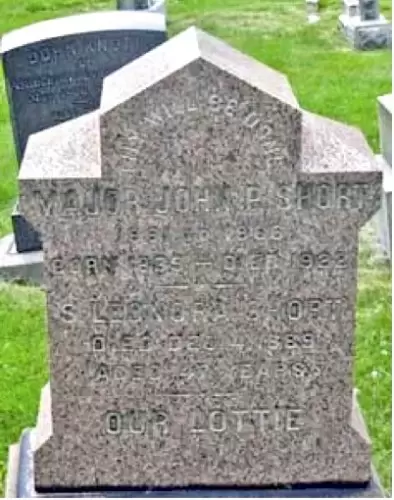
SHORTER, ELI SIMMS (1840-1887). Quartermaster sergeant and adjutant, 17th Georgia Infantry, Company H; private, 2nd Georgia Infantry, Company G, Confederate States of America. Born into a prominent family in Columbus, Georgia, his grandfather was the first judge of the Superior Court of Georgia, and his uncle, John Shorter, was a wartime governor of Alabama. A graduate of the University of North Carolina, Chapel Hill, Eli Shorter entered the Confederate service as a private on April 16, 1861, and mustered into Company G of the 2nd Georgia Infantry. He was listed as sick at Richmond, Virginia, in October 1861. Transferred to Company H of the 17th Georgia on an unknown date, he rose to quartermaster sergeant, and was transferred to the Field and Staff. According to his obituary in The New York Times, he was an adjutant on the staff of General Gordon Benning. On April 9, 1865, he surrendered and was paroled at Appomattox Court House, Virginia.
After the War, in 1865, Shorter went to Philadelphia, Pennsylvania, studying there at the University of Pennsylvania, and earning a medical degree in 1870. After practicing for a year in New Orleans, Louisiana, he moved to New York City setting up an office on Broome Street where he worked throughout his life. He is listed as a physician in the 1877 New York City Directory. His brother, John U. Shorter (see), also served the Confederacy. He last lived at 367 Broome Street in Manhattan. He died of pneumonia. Section 15, lot 17263, grave 763.


SHORTER, JOHN URQUHART (1844-1904). First lieutenant and adjutant, 18th Alabama Infantry; 31st Alabama Infantry, Confederate States of America. Shorter, who was born in Columbus, Georgia, studied law at the office of his uncle, John Gill Shorter, an ardent secessionist who later became the governor of Alabama during the Civil War from 1861-1863. A first lieutenant and adjutant in the 18th Alabama Infantry, he later served in that capacity with the 31st Alabama as of May 1, 1863. Captured at Champion Hill, Mississippi, on May 16, 1863, he was imprisoned at Indianapolis on June 15, 1863, and transferred to City Point near Sandusky, Ohio, on February 25, 1865. He was paroled at Tallahassee, Florida, on May 18, 1865.
After the War, Shorter moved to New York in 1868, and in the early 1870s, became the assistant district attorney of Kings County, an appointed position that he held for twelve years before returning to private practice. During that time, he became a subscribing member of the George Rickard Post #362 of the G.A.R. causing a furor among members of other G.A.R. posts citing that he had political intentions and that no ex-rebel should be granted a place in the organization. His obituary in The New York Times states that in 1882 he was elected as an honorary member of the 173rd New York Volunteers, the only ex-Confederate living in Brooklyn with that distinction. His brother, Eli Shorter (see) also served the Confederacy. He last lived at 61 Fifth Avenue in Brooklyn. Section 128, lot 31394, grave 176.



SHOTWELL, ROBERT M. (1821-1894). Sergeant, 127th New York Infantry, Company F. A New York City native who was employed as a bank clerk, Shotwell was 5′ 7″ tall with blue eyes, dark hair and a dark complexion. During the Civil War, he enlisted as a private at Brooklyn on July 29, 1862, and may have been slated for an unassigned company in the 67th New York on August 18 before he mustered into the 127th New York on September 8. After he was promoted to sergeant on or about April 1, 1863, he was reduced in rank to private on July 1. As per his muster roll, he was detached to the Pioneer Corps, a group that worked with engineers, clearing woods and building roads, from April until June 1864. On December 6, 1864, he was wounded in action at Gregory’s Landing, South Carolina, and, according to his muster roll, was in the General Hospital at Hilton Head, South Carolina, until February 1865. He mustered out on June 30, 1865, at Charleston, South Carolina.
On August 16, 1865, Shotwell’s application for an invalid pension was approved, certificate 75,536. As per the census of 1880, he was employed as a bookkeeper. His last residence was on Schenectady Avenue in Brooklyn. He died from senility in 1894. Sarah Shotwell, who is interred with him, applied for and received a widow’s pension in 1895, certificate 410, 375. Section 82, lot 3268, grave 7.

SHURTLEFF, EDWARD S. (1837-1896). Acting master, United States Navy. A native New Yorker, he was appointed acting master ensign on July 31, 1863, and was promoted to acting master on March 7, 1865. He was discharged on July 22, 1865. He died of apoplexy at his home at 318 East 123rd Street, Manhattan. Section 158, lot 15759, grave 1.
SHUTTLEWORTH, JOHN GEORGE (1844-1876). Private, 2nd Florida Infantry, Company A, Confederate States of America. Shuttleworth, who was born in Pensacola, Florida, was the son of William Shuttleworth (see), an officer in the United States Marine Corps, who remained loyal to the Union throughout the War, although his family lived in Pensacola. John Shuttleworth was 5′ 7½” tall, with blue eyes, dark hair and complexion. After enlisting at Pensacola as a private on August 29, 1861, he immediately mustered into Company A of the 2nd Florida Infantry. That September, he appeared on the hospital muster rolls where he was detached as a nurse. He deserted to Union forces, was sent to Captain Leslie at City Point, Virginia, on September 9, 1864, took an oath of allegiance to the Union on that day, and was transferred to Pensacola by the Provost Marshal General’s Department in Washington, D.C., the next day. After the War, Shuttleworth moved to New York City, where his father lived, received his medical degree from the University Medical College in New York in 1867, and worked as a physician. He died of phthisis pulmonalis in Pensacola. Section F, lot 20157.


SHUTTLEWORTH, WILLIAM LOUIS (1812-1871). Colonel, United States Marine Corps. Born in Piscataway, New Jersey, he entered the Navy in 1831, was promoted to carpenter in April 1834, and transferred to the United States Marine Corps as a second lieutenant on February 28, 1839. Rising through the ranks, he became a first lieutenant and was brevetted captain on March 16, 1847, for “conspicuous gallantry at the bombardment and capture of Vera Cruz in the Mexican War.” He rose to captain on September 28, 1857. In 1860, he was superintendent of construction of the marine barracks at the Brooklyn Navy Yard but was ordered to the helm of the Minnesota in April 1861 at the onset of the Civil War, and commanded her for two years during which time he participated in the captures of Forts Clark and Hatteras. At Hatteras, he cut off the retreat of stragglers from the fort during a time of heavy surf.
Major General Benjamin Butler, in his report of August 30, 1861, from the USS Minnesota, wrote about his visits to the Adelaide and George Peabody, which were deployed to Hatteras Inlet, North Carolina. Butler wrote, “Captain Shuttleworth, of the Marine Corps, deserves well for his loyalty and efficiency in his active detachment of marines…” In April 1863, he was assigned to Pensacola, Florida (where his young children and their maternal relatives lived) , and was ordered to hold the navy yard. He commanded the marines there for two years. On June 10, 1864, he was promoted to major, lieutenant colonel and colonel.
On September 8, 1864, the following letter describes how Shuttleworth’s family, like many others, was torn apart by the War. Captain J. McEntee wrote to headquarters to note the desertion of five Confederate soldiers. He said, “One of the deserters examined this morning is a son of Lieutenant Colonel Shuttleworth, of the Marine Corps, now stationed at Pensacola Navy Yard. He has been in the rebel army three years, is a very intelligent youth, but left the Confederate service because he considers their cause hopeless.” In 1865, he was placed in charge of the marine barracks at the Brooklyn Navy Yard. In December 1865, he suffered from vertigo. He retired from his long military career in 1869. Roger Hunt included Shuttleworth and references to his service in his latest book in his “Colonels in Blue” series, subtitled, U.S. Colored Troops, U.S. Armed forces, Staff Officers and Special Units (McFarland Press).
As per Find a Grave, he married his first wife, Clotilda Santiago Brosnaham in 1843. The couple had two sons, John and William Rodman, and a daughter named Mary; William died at age five in 1850 and Mary died in 1848 at age one. Clotilda was the daughter of a prominent Navy physician stationed in Pensacola and from Catskill, New York; in 1850, she died in childbirth. As per a biography of Shuttleworth on the Horse Soldier, a site that sells military objects, William Louis Shuttleworth wrote a poem about the deaths of Clotilda and William Rodman that was published in the Home Journal. Shuttleworth’s rare sword sold on that site for $35,000. In 1851, he married Amanda Broshaham, his first wife’s half sister; they had three children, Mary Ella, born in 1852; Samuel, born in 1853, who lived for only six weeks; and David, born in 1855. Tragically, Amanda died in 1858.
His son, John Shuttleworth (see), who was raised in Pensacola, served with the Confederacy and is interred with his father. According to a descendant, it was very hard for William Louis Shuttleworth to leave his young family in Pensacola and serve with the Union. After Shuttleworth’s second wife died young, their children went to live with their father in Brooklyn when he was assigned to the Navy Yard there. He last lived at 270 Cumberland Street in Brooklyn. His death was attributed to apoplexy. He is buried with his mother, son John and infant son Samuel. Section F, lot 20157.
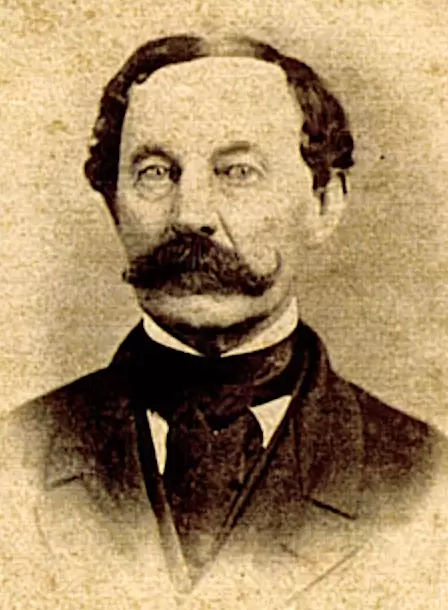


SIBELL, JOHN W. (or J. W.) (1832-1895). Second lieutenant, 25th New York Infantry, Company H; private, 7th Regiment, New York State Militia, Company A. Sibell enlisted as a private on April 17, 1861, at New York City, mustered into Company A of the 7th Regiment, and mustered out at New York City on June 3, 1861. On November 1, 1861, he re-enlisted as a second lieutenant and mustered into Company H of the 25th New York. He resigned on June 4, 1862. In 1886, his application for an invalid pension was granted, certificate 893,884. At the time of his death, from paralysis, he lived in Brooklyn. Huldah Sibell, who is interred with him, applied for and received a widow’s pension in 1895, certificate 419,746. Section 33, lot 4790.
SIBREE (or SEBREE), WILLIAM (1841-1862). Private, 1st New York Marine Artillery, Company A. Sibree is not buried at Green-Wood; a cenotaph in his family’s lot honors his memory. Sibree entered service with the designation of “boy,” served with the 1st New York Marine Artillery, and left service with the rank of private. His cenotaph confirms his participation in the Civil War and states that he died on October 26, 1862, at Beaufort, South Carolina, “while in the service of the United States Navy.” Section 104, lot 6881.
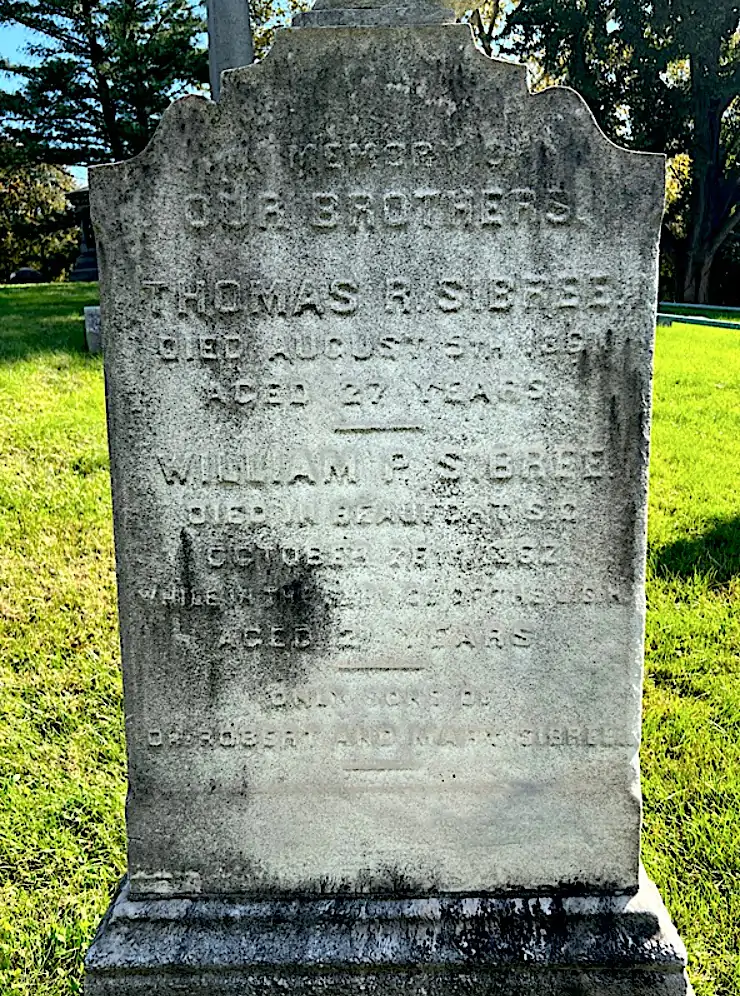

SICKLES, TERESA Da PONTE BAGIOLI (1836-1867). Military wife and society hostess. Teresa Sickles, a beautiful and well-schooled young woman, who spoke many languages, had the middle name of her grandfather, Lorenzo Da Ponte, one of Mozart’s librettists who later lived in New York City. As per Maggie MacLean in her blog, Civil War Women, Teresa’s father, Antonio Bagioli, was a noted singing teacher.
Daniel Sickles, a future controversial lawyer, Congressman and Civil War general, first met the family and three-year-old Teresa when he was tutored by Da Ponte and lived in the household for a short time. Subsequently, when Sickles, an assemblyman and known womanizer, renewed his friendship with Teresa, they married in a civil ceremony, over the objections of her parents, on September 17, 1852, she being a teenager and he, a man in his thirties; they were later married in a Catholic ceremony officiated by John Hughes, the Archbishop of New York City. Daniel Sickles became corporation counsel of New York City (despite a past history that included charges of fraud) and was then appointed to a diplomatic post in England, accompanied by a prostitute, Fanny White. MacLean notes that Sickles was censured by the New York State Assembly for presenting a prostitute to Queen Victoria. Seven months after their marriage, Laura Buchanan Sickles, their only child, was born. As per several sources, Teresa was summoned to England by her husband but did not like living there and returned home where she stayed with her parents. From 1856 to 1857, Sickles, a Democrat, served in the New York State Senate.
After Sickles was elected to Congress (1857-1861), the couple became popular in Washington, D.C., society where Teresa was known for hosting lovely dinner parties every Thursday and receptions for ladies every Tuesday; Teresa’s language fluency made her a most popular hostess. Purportedly, the couple became friends with Abraham and Mary Todd Lincoln; Teresa allegedly attended Mrs. Lincoln’s séances. During their time in Washington, Teresa befriended Philip Barton Key, the District Attorney for the District of Columbia and son of Francis Scott Key, composer of the national anthem, The Star-Spangled Banner. Philip Barton Key, a widower with children, was a popular escort for married women and he and Teresa soon became lovers. Key rented a house for their trysts, and when Daniel Sickles was informed in an anonymous letter about the affair, he forced Teresa to write a confession. Sickles then confronted Key outside his house on Lafayette Square on February 27, 1859, and although Key shouted for mercy, Sickles shot him several times with one of the three revolvers that he was carrying, even after Key had fallen after been shot in the groin; Key was unarmed.
Daniel Sickles was brought to trial for murder, defended by many prominent lawyers including Edwin Stanton, the future Secretary of War. Of the murder, Daniel Sickles allegedly said, “He deserved it.” As per MacLean, Teresa’s mother visited him in jail and said that Teresa was distracted with grief, shame and sorrow, and that the loss of her wedding ring, which Sickles had taken, was more than Teresa could bear. Given the double standard for infidelity in the mid-nineteenth century, Daniel Sickles had the public on his side whereas Teresa was scorned. The trial which ran from April 4 through April 29, 1859, was a media sensation and, although not admissible in court, Teresa’s confession was printed in the newspaper. Sickles, whose defense was that any married man would have done what he did, was acquitted of all charges by an all-male jury (standard for the time); he was the first criminal defendant to successfully use the plea of temporary insanity; he walked away scot-free. Although she was disparaged by the public after the infamous trial, Sickles took Teresa back, against the public will, after she begged for forgiveness. Sickles returned to Washington alone, did not return to his Congressional seat in the next election cycle and the two were essentially estranged. Sadly, Teresa retired to the home of her parents on West 91st Street in Manhattan.
As per Matt Atkinson in his ranger talk at Gettysburg on November 14, 2014, Daniel Sickles, was in the right place at the right time at the start of the Civil War. A Democrat with many personal funds, he raised the Excelsior Brigade and was nominated by President Abraham Lincoln to be its brigadier general, but Congress refused to approve his commission and he had to give up his command in March 1862. Sickles then called in his favors and returned to his post in May 24, 1862. Sickles fought in the Peninsula Campaign, allied himself with General Joseph Hooker, and became a major general on November 29, 1862. Sickles then made controversial moves defying the orders of Hooker at the Battle of Chancellorsville on May 2, 1863, and then at Gettysburg on July 2, 1863, when he defied the orders of General George G. Meade, who commanded the Army of the Potomac. Sickles’s action, ordering his corps out to the Peach Orchard, creating a bulge in the Union line, against the orders of his commander, cost 30 percent of his men and cost him his right leg when a 12-pound cannonball struck him while he was astride his horse. Taken to a hospital in Washington, D.C., he promoted his own version of events and smeared the name of Meade. Ultimately, 34 years later, Sickles managed to get himself awarded the Medal of Honor for gallantry at Gettysburg. He never returned to the battlefield after his injury but was sent by President Lincoln to Colombia in early 1865 to secure a treaty that allowed troops to pass through the isthmus of Panama. President Andrew Johnson later appointed Sickles military governor of the Carolinas from 1865 through 1867 but relieved him of duties when they sparred over policies.
Meanwhile, Teresa Sickles lived a lonely life, eventually contracting and succumbing to tuberculosis. Daniel Sickles, who was in the Carolinas at the time of her death, attended her funeral mass where four of the pallbearers were Union Army generals, including Alfred Pleasanton, and Henry Tremain, his Gettysburg aide; James Topham Brady, one of the lawyers who defended Sickles in the Philip Barton Key trial was also her pallbearer. Unfortunately, Laura Sickles, the couple’s daughter, became an alcoholic. Teresa Sickles is buried in the Sickles’s plot at Green-Wood along with her parents and daughter. William Sickles (see), Daniel’s uncle, who served in the Civil War, is buried in the same lot. Daniel Sickles is buried at Arlington National Cemetery. Section K, lot 18923.


SICKLES, WILLIAM H. (1806-1870). Second lieutenant, 74th New York Infantry, Company E. A New York City native, he was a hatter by trade who first served in the 4th Infantry, Company C, of the United States Army, after enlisting at New York City on October 29, 1833. He was discharged at Ft. Clinch, Florida, on October 30, 1836. At that time, he was 5′ 6½” tall with brown hair, a light complexion and blue-gray eyes. Sickles re-enlisted on July 28, 1837, served as a private with the 1st Artillery, Company H, and was discharged on June 1, 1840. Remaining with the 1st Artillery on June 1, 1840, he listed his occupation as soldier and served until his discharge on June 1, 1845. The 1st Artillery was stationed in Florida during the Seminole Wars and then moved to New York and the Maine border where a dispute was averted in the early 1840s.
During the Civil War, Sickles enlisted at New York City as a second lieutenant on June 23, 1862, and was commissioned into the 74th New York on April 25, 1863. He was dishonorably discharged on June 27, 1863. According to the Brooklyn Directories of 1863, 1864, 1866, and 1868, he was a hatter; as per his death certificate, he was employed as a watchman. His last residence was 818 Flushing Avenue in Brooklyn. Sickles died from dysentery. Section K, lot 18923.

SIDDONS, CURTIS (1838-1912). Sergeant, 84th Regiment, New York State National Guard, Company F; private, 8th Regiment, New York State National Guard, Company D. Originally from the Isle of Man, Siddons enlisted as a private at New York City on May 29, 1862, mustered into Company D of the 8th New York State National Guard, and mustered out after three months on September 10 at New York City. He re-enlisted a year later as a private, served with the 84th Regiment’s National Guard in 1863 for 30 days, and was discharged with the rank of corporal. When the 84th was reactivated in 1864, Siddons returned to the same company for 100 days and was promoted to sergeant. He applied for and received an invalid pension in 1893, certificate 861,000. His last address was 576 West 161st Street, New York City. He succumbed to phthisis pulmonalis. Section 192, lot 24646, grave 2.

SIDELL, WILLIAM HENRY (1810-1873). Brigadier general and colonel by brevet; lieutenant colonel, 10th Regiment, United States Army; major, 15th Regiment, United States Army. Born in New York City, he graduated 6th in his class from the United States Military Academy in 1833, was brevetted second lieutenant artillery on July 1, but resigned his commission on October 1, 1833, to pursue a career in civil engineering when he was not assigned to the engineer corps. Sidell was in succession the city surveyor of New York, assistant engineer of the Croton Aqueduct, division engineer for the Long Island Railroad, and chief engineer of the Panama Railroad. He worked on various other railroads and surveys until the Civil War began, at which time he volunteered for service.
On May 14, 1861, Sidell entered the regular army as major of the 15th Regiment and organized recruits in Louisville, Kentucky, and Nashville, Tennessee. In 1862, he was appointed acting assistant adjutant-general of the Department of the Cumberland and subsequently became the acting provost marshal for Kentucky beginning in May of 1863. Over 200,000 men were mustered in and out of the service by the system he organized and ran. On May 6, 1864, he was commissioned into the 10th Regiment, United States Army, as lieutenant colonel. Judge Advocate General J. Holt wrote to Secretary of War E. M. Stanton on July 31, 1864, citing his work recruiting black troops in Kentucky, “The service, under the vigilant and faithful administration of Major Sidell and his subordinates, is marked by energy and discretion, and promises soon to bring to the support of the Government a numerous and zealous body of soldiery, of a class whose courage and loyalty have been conspicuous on so many fields.” He was brevetted colonel of the United States Army on March 13, 1865, “for meritorious and faithful service in the recruitment of the Armies of the United States,” and on the same day was brevetted brigadier general “for faithful and efficient service during the War.”

He was on frontier duty in the Dakota Territory from 1867-1869, then was at the Recruiting Depot at Fort Leavenworth, Kansas, until October 27, 1870, when he took sick. After suffering paralysis, he retired from the military on December 15, 1870. His son, William H. Sidell (see), died during the War.
George W. Cullum (see), a classmate of Sidell, who compiled a register of West Point graduates, Biographical Register of the Officers and Graduates of the United States Military Academy, said of him in a personal note that lauded his talent and social skills, “…With greater persistency of purpose, and closer application, Sidell might have become a luminary of science; with his clear conceptions and great command of language, by study and patience he could have been an author of no ordinary note; and had he continued in military instead of civil pursuits, he doubtless would have attained eminence in an army career. But a restless eagerness to quickly realize the cravings of his ambition, and the incense of flattery which won him from contemplation to society, were the powerful drawbacks to that higher elevation which his natural talents, logical mind, keen perceptions, and excellent education should have insured….” He last lived at 250 Fifth Avenue in New York. He died of Bright’s disease. Section 35, lot 4654.
SIDELL, JR., WILLIAM H. (1835-1864). Second lieutenant, 47th New York Infantry, Company E; sergeant, 5th New York Infantry, Company A. The son of William Henry Sidell (see), he stood 5′ 9¾” tall with blue eyes and light brown hair. A salesman when he enlisted as a sergeant at New York City on April 25, 1861, he mustered into the 5th New York on May 9 and was detailed to the quartermaster’s department. Reduced to ranks on June 15, 1861, he was promoted to commissary sergeant on August 9 and transferred to Field and Staff, then reduced to private and returned to Company A on October 10, 1861. After he was detailed to the ordnance department on January 8, 1862, he was promoted to second lieutenant on February 7 and was discharged to accept his commission on March 24 in the 47th New York, but did not muster in that rank. He died on August 21, 1864, in New York; his cause of death is listed in the cemetery records as a “casualty.” His last residence was 59 West 57th Street in New York City. Section 35, lot 4654.
SIEDRICH (or SEATERICK), THEODORE H. (1839-1867). Third corporal, 21st Louisiana Infantry, Company A (later designated Company H), Confederate States of America. Born in Germany, Siedrich enlisted as a corporal at New Orleans, Louisiana, on June 16, 1861, and mustered into Company A (sappers and miners) of the 21st Louisiana Infantry, also known as Patton’s Infantry, for twelve months. Further details of his service in the Confederate Army are unknown. His last residence was 304 Atlantic Avenue in Brooklyn. He died from tuberculosis. Section 85, lot 3129, grave 63.
SIEMAN, GEORGE (or J.) (1834-1872). Private, 4th New York Heavy Artillery, Battery B. A native of Germany, Sieman enlisted at Brooklyn as a private on September 27, 1861. He mustered into Battery B of the 4th New York Heavy Artillery on October 7. No further details of his service are known. He last lived at 338 Navy Street, Brooklyn. Section 109, lot 45.
SIGISON (or SICKERSON), JOHN (1834-1863). Private, 38th New York Infantry, Company I; 40th New York Infantry, Company E. Born in New York, he first mustered into the 55th New York but then transferred into Company I of the 38th New York on December 23, 1862. On June 6, 1863, he transferred into the 40th New York. A month later, he was mortally wounded on July 2 at the Battle of Gettysburg, Pennsylvania, and succumbed on July 21. Section 40, lot 5450.


SILVA, MANUEL (1831-1861). Captain, 73rd New York Infantry, Company F. Born in New York, he enlisted as a captain on May 3, 1861, at Staten Island, was commissioned into the 73rd New York on July 20 of that year, and died of typhoid fever a month later on August 17. He last lived in New York City. Bridget Silva applied for and received a widow’s pension in 1862, certificate 4,142. Section 11, lot 5032.
SILVA, THEODORE VICTOR (1846-1906). Private, 22nd Regiment, New York State National Guard, Company G. Born in New York City, he served in the 22nd Regiment’s National Guard for 30 days in 1863. He was a member of the Alexander Hamilton Post #182 of the G.A.R. As per his obituary in the Brooklyn Standard Union, which confirmed his Civil War service, he was the proprietor of the Hotel Colonial in Asbury Park, New Jersey, for the last six years of his life. He last resided at 330 West 55th Street in Manhattan. He died of cystitis in Ticonderoga, New York. Section 189, lot 17121, grave 2.
SILVA, VALENTINE MOTT CUYLER (1844-1918). Hospital steward, United States Army; corporal, 9th New York Infantry, Company K. A New Yorker by birth, Silva enlisted as a private at New York City on August 9, 1861, mustered immediately into the 9th New York, and was promoted to corporal at some point. Upon his promotion to hospital steward on September 18, 1862, he mustered into the United States Army Hospital Stewards, and served there until he was discharged for promotion to second lieutenant in the 12th United States Army.
Silva served in the Army until May 19, 1874. While serving in the 21st Infantry, he was an officer in the Modoc War in December 1872, the last of the Indian Wars in Oregon and California. Remaining in the West after his military career ended, he was a director and officer in the Ogden City [Utah] Electric Light Company. In 1906, his application for a pension was granted, certificate 1,123,688. He died from Bright’s disease in Portland, Oregon, on July 14, 1918, and was interred at Green-Wood on February 25, 1920. Section 64, lot 22356, grave 2.



SILVEY, JAMES (1818-1888). Captain, 133rd New York Infantry, Company A. He enlisted at age 46 on August 12, 1862, at New York City, was commissioned into the 133rd New York as a captain on September 24, and was discharged on July 19, 1864. His died at the Soldiers’ Home in Bath, New York. Section 115, lot 20934.

SIMONS (or SIMON), EDWIN A. (1841-1890). Private, 5th New York Infantry, Company D. Born in New York City, he enlisted there as a private on April 25, 1861, mustered into the 5th on May 9, and was discharged for disability on June 4, 1861, at Camp Hamilton in Fort Monroe, Virginia. His last residence was 1690 Park Avenue in Manhattan. He succumbed to heart disease. Section 66, lot 12607.

SIMONS (or SIMON), GEORGE (1845-1906). Private, 139th New York Infantry, Company K. Born in Brooklyn, Simon enlisted there as a private on August 28, 1862, mustered into Company K of the 139th New York on September 9, and was discharged on June 19, 1865, at Richmond, Virginia.
Simons became a member of the G.A.R.’s James H. Perry Post #89 in Brooklyn in 1881. In 1890, he applied for an invalid pension that was granted under certificate 756,147. His last residence was 114 Himrod Street in Brooklyn. At some point after his death from cancer, his wife applied for and received a widow’s pension, certificate 636,776. Section 20, lot 20944, grave 4.
SIMONSON, CORNELIUS A. (1842-1879). First lieutenant, 132nd New York Infantry, Company B; sergeant, 83rd New York Infantry, Company D. A native of New York City, he enlisted there as a private on May 27, 1861, and mustered into the 83rd New York that day. He rose to corporal on October 16, 1861, to sergeant on about June 15, 1862, and was discharged for promotion on September 21, 1862, when he was commissioned into the 132nd New York Infantry as a first lieutenant. He was discharged on November 8, 1862. He last resided at 326 West 23rd Street in Manhattan. His death was caused by a lumbar abscess. Section 24, lot 3516.

SIMPKINS, DILLON (1833-1872). Private, 51st New York Infantry, Company E. A New York native, he enlisted at New York City on October 15, 1861, the same date that he mustered into the 51st New York, and deserted on December 5, 1861, at Annapolis, Maryland. His last address was 684 Water Street in Manhattan. Simpkins died from pneumonia. Section 11, lot 6862.
SIMPSON, EDWARD F. (1828-1870). Private, 182nd New York Infantry, Company K; Veteran Reserve Corps. A native of England, Simpson enlisted as a private at New York City on September 23, 1862, and mustered into the 182nd New York on November 17. On September 21, 1864, he transferred into the Veteran Reserve Corps. Further details of that service are unknown. His last residence was 310 West 19th Street in Manhattan. His death was attributed to “coup de soleil,” or sunburn. Section 186, lot 18998.
SIMPSON, GEORGE H. (1837-1903). Quartermaster sergeant, 5th New York Cavalry. Born in Scotland, Simpson enlisted at New York City and mustered into the Field and Staff of the 5th New York Cavalry on November 4, 1861. He was discharged on February 18, 1862. He died from nephritis. Section 2, lot 5499, grave 114.

SIMPSON, GEORGE H. (1837-1922). Captain, 133rd New York Infantry, Companies F and C; sergeant, 71st Regiment, New York State National Guard, Company A. After having served as a sergeant in the 71st Regiment for three months from May 28-September 2, 1862, he enlisted as a second lieutenant at New York City on September 17, 1862, and was commissioned into the 133rd New York on September 24. He was promoted to first lieutenant on June 17, 1863, effective upon his transfer to Company C, and subsequently promoted to captain on January 1, 1864, the same day he was transferred back to Company F. He mustered out on June 6, 1865, at Washington, D.C.
In 1907, Simpson’s application for an invalid pension was granted, certificate 1,137,127. He last lived in New York City at 35 St. Nicholas Terrace. His death was attributed to nephritis. Cordelia Simpson, who is interred with him, applied for and received a pension in 1922, certificate 930,272. Section 62, lot 32115.

SIMPSON (or SAMPSON), JAMES H. (1842-1862). Private, 82nd New York Infantry, Companies A and E. Born in New York and a resident of 126 Hammond Street in Manhattan, Simpson enlisted at New York City as a private on May 21, 1861, mustered into Company A of the 82nd that day, and was transferred into Company E two months later on July 15. He was killed in battle on September 17, 1862, at Antietam, Maryland. Section 115, lot 13536 (Soldiers’ Lot), grave 50.
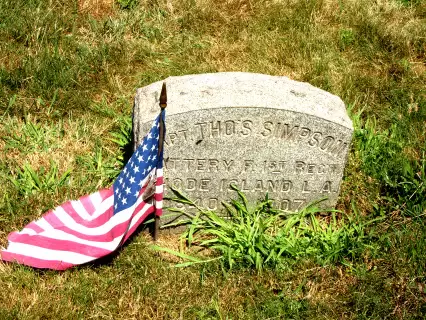
SIMPSON, THOMAS (1840-1907). Captain, 1st Rhode Island Light Artillery, Battery F. A resident of Providence, Rhode Island, his birthplace, he enlisted as a private on April 17, 1861, mustered into the 1st Rhode Island Light Artillery on May 2, and mustered out on August 6. He was promoted to second lieutenant on October 17, 1861, effective upon his commission into Battery F of the 1st Rhode Island on October 29. During 1862, he was detached from April 14-May 15 and again from July 30-August 1.
Simpson became a first lieutenant on November 5, 1862, and during his service commanded the battery from April 9, 1863, until his absence for twenty days beginning September 25, 1863. He was in command again on November 23, 1863, on December 23, 1863, and from May 16, 1864, until he was captured. Taken as a prisoner of war on October 27, 1864, at Charles City Court House, Virginia, he was paroled on February 2, 1865, and reported for duty at Annapolis, Maryland, on February 23. He rose to captain on March 31, 1865, was formally exchanged on April 15, 1865 (when he was ordered to the regiment), and mustered out on June 27, 1865, at Richmond, Virginia. His last residence was in Puerto Plata, Santo Domingo. He succumbed to cancer. His gravestone confirms his service in the 1st Rhode Island. Section 126, lot 16874, grave 59.
SIMS, CHARLES (1837-1899). Private, 48th New York Infantry, Company H. A native New Yorker and brother of Samuel (see) and Palin (see), he enlisted at Brooklyn on August 20, 1862, and mustered into the 48th that day. As per his muster roll, he was a glass stainer who was 5”¾” tall with hazel eyes, dark hair and a light complexion. His muster roll notes that he was on detached duty with Division Pioneers in April 1865. Sims mustered out at Raleigh, North Carolina, on June 27, 1865.
In 1891, Sims appeared before the Commissioner of Deeds and swore in a “General Affidavit” that he contracted malaria during his service at Fort Pulaski [Georgia] on or about September 1862 and that the effects of the disease are “of a permanent character.” Sims applied for and received an invalid pension under certificate 899,457. As per his obituary in the Brooklyn Standard Union, which confirms his Civil War service and the service of his brothers Palin and Samuel, Charles Sims’s funeral was held at the home of his nephew, Edward S. Darling, at 66th Street between 13th and 14th Avenues. Services as graveside were performed with military honors. His last residence was the New York State Home for Soldiers’ and Sailors’ in Bath, New York. Section 53, lot 12512, grave 648.
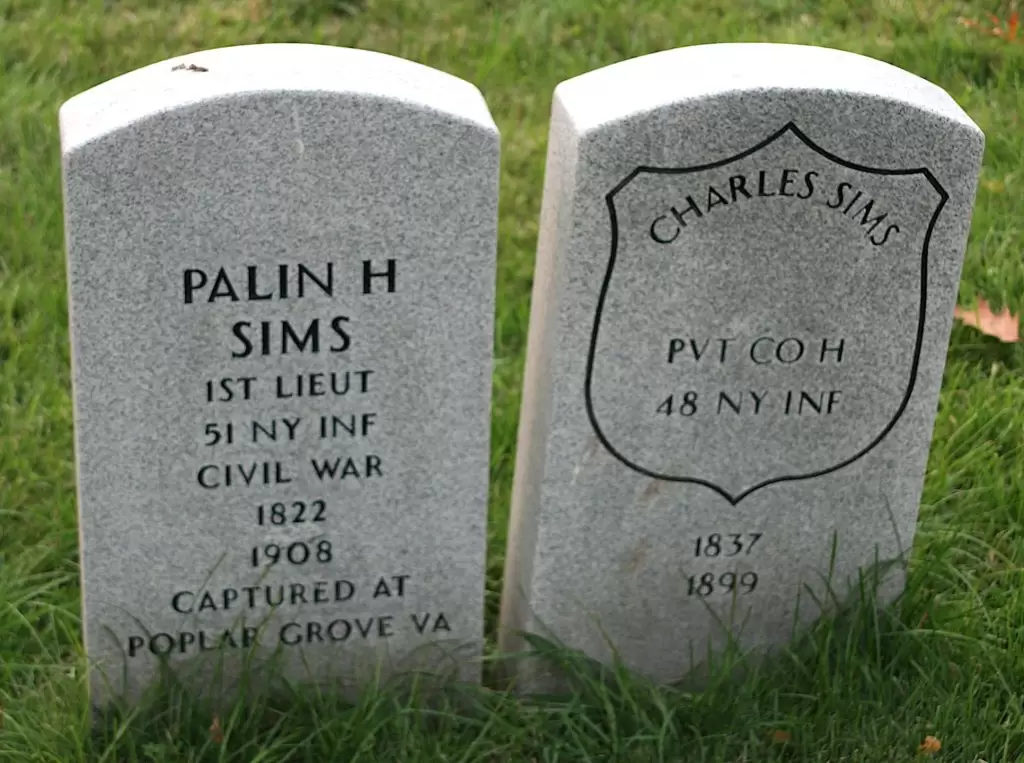


SIMS, JASPER N. (1840-1896). Private, 13th Regiment, New York State Militia, Company D. A native of England, Sims served for three months in 1861 in the 13th New York State Militia. As per the Brooklyn Directories of 1864, 1866, and 1868, he was a printer. He last lived in Brooklyn at 1036 Atlantic Avenue. His death was caused by epithelioma, a skin cancer. Section 127, lot 8259, grave 367.

SIMS, LUCY HALE (1853-1889). “Adopted daughter” of the 13th New York Regiment. Lucy Sims became an orphan after her father, Samuel Sims (see), a captain of the 51st New York and former second lieutenant of the 13th Regiment, died at the Mine Explosion, or the Battle of the Crater, at Petersburg, Virginia, on July 30, 1864. (Her mother died in 1860.) In 1866, the members of the 13th Regiment officially introduced her at the Armory at Flatbush Avenue and Hanson Place in Brooklyn and agreed to make her a “daughter of the regiment” until she reached the age of majority. As such, each member promised to contribute to her welfare and education at the rate of $1 per year, a committee was established to carry out the details, and a veteran designated to be her “father.”
Approximately $6,000 was raised over four years and Lucy Sims attended preparatory school and Vassar College where she was trained to be a teacher and graduated with honors. She then taught for many years at P.S. 11 in Brooklyn. Lucretia Sims, Samuel’s sister and the guardian of Sims’ three children along with his mother, applied for and received an increase in the minors’ pension in 1867, certificate 103,585.
In 1880, James F. Steele, a Confederate soldier, contacted the New York Herald in an effort to return Samuel Sims’ sword to his family; it was accepted by Lucy, the sole survivor. The 13th contacted Mr. Steele by telegraph and both the regiment and Lucy Sims, who was still considered a daughter of the unit, were most appreciative that the sword could now be cherished as a family heirloom. Her uncles, Charles Sims (see) and Palin Sims (see) also served in the Civil War. Lucy Sims died from tuberculosis at her home at 1311 Dean Street in Brooklyn. She is buried alongside her father where the tombstone is inscribed, Lucy H. Sims, Daughter of the 13th Regiment, N.G.S.N.Y. Section 53, lot 12512.

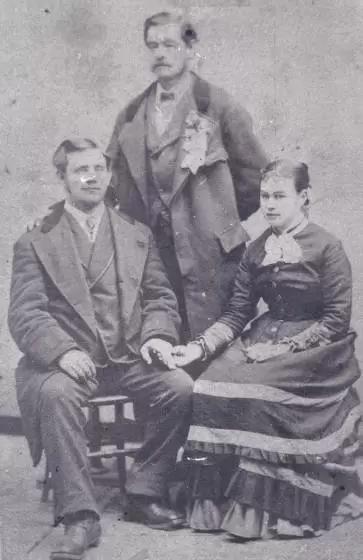
SIMS, PALIN HARRIS (1822-1908). First lieutenant, 51st New York Infantry, Companies G and B. After enlisting at Brooklyn as a private on September 15, 1861, Sims, a native of New York City, mustered into Company G of the 51st New York, also known as the Shephard Rifles, on September 30. He was 5′ 10¼” tall with a light complexion and blue eyes. A month later he became an ordnance sergeant on October 21, and rose to second lieutenant on October 16, 1862. He was promoted to first lieutenant on April 20, 1864, effective upon his transfer to Company B that day. Two days later, he transferred back to Company G.
After Sims was taken as a prisoner of war at Poplar Grove Church, Virginia, on September 30, 1864, he was incarcerated at Danville (Virginia), Salisbury (North Carolina), and then at the infamous Libby Prison in Richmond, Virginia, before he was exchanged on March 20, 1865. During his time in confinement, he carved wood with a penknife and made many useful objects. Sims was hospitalized at Annapolis, Maryland, before he mustered out on July 25, 1865, at Alexandria, Virginia.
After the Civil War, Sims returned to Brooklyn and resumed work in the plumbing business on Atlantic Avenue. He was active in the Rankin Post#10 of the G.A.R. According to the 1870 census, Sims’ personal estate was valued at $2500. Due to declining health, he had to retire completely from the trade in 1876. His claim for an invalid pension based on rheumatism and severe affliction of the kidneys, physical and mental disabilities caused by exposure, starvation and other conditions he was subjected to as a prisoner was granted in 1889, certificate 704,121. In 1905, his application for an increase in his pension to $30 (from $12 per month) was awarded, “caused by the toil and long confinement in rebel prisons and that in consequence of the above and his advanced age, he is entirely unable to engage in any labor of any kind; that he is without means, and has been provided for by his son-in-law and daughter, etc.”
Sims and his son-in-law, Edward Darling, are given credit for being instrumental in getting the Brooklyn Heights Railroad Company to place a “stationary car” (a place to stand protected from the elements) at Bay Ridge Avenue and 13th Street, for the use of those traveling on the Bensonhurst line. At the time of his death, listed as from endocarditis, Sims was known far and wide as “The Old Soldier.” The following excerpt from an article in the Brooklyn Daily Eagle dated July 5, 1908, entitled “Honors Paid Aged Veteran,” captures the esteem and affection with which he was held:
If the sun has ceased to shine, there perhaps would not have been greater gloom in Lefferts Park this week than when Lt. Palin H. Sims, “The Old Soldier,” an honorable, brave and battle scarred warrior, who had served throughout the entire Civil War and suffered incarceration in the famous Libby Prison, breathed his last at the home of his son-in-law, Edward L. Darling. The old veteran who was 86 years old was one of the most honored citizens of the southern section of Brooklyn and the idol of the children from whose eyes there rushed tears of intense sadness when it was announced that the warrior had answered the bugle call of the General of All.
His brothers, Charles (see) and Samuel (see), also served in the war. His last address was 1232 67th Street in Brooklyn. Section 53, lot 12512, grave 648.



SIMS, SAMUEL HARRIS (1829-1864). Captain, 51st New York Infantry, Company G; second lieutenant, 13th Regiment, New York State Militia, Company B. A native of New York City, Sims’s brothers, Charles (see) and Palin (see), also served in the Civil War. At the time of his enlistment, he was employed in the stained-glass trade and was 5′ 9″ with a light complexion, brown hair and blue eyes. He enlisted on April 23, 1861, at Brooklyn, as a second lieutenant. On May 17, he joined Company B of the 13th Regiment for three months and mustered out at Brooklyn on August 6, 1861. He re-enlisted as a private on August 16, 1861, was promoted to captain on September 10, and passed examinations at the School of the Soldier and Company of the Depot of Volunteers of the State of New York on September 20. On October 15, he mustered into Company G of the 51st New York Infantry.
Sims’s letter to his sister from the gunboat Lancer on January 8, 1862, revealed his concern for his family and told of his impending mission and that of his brother, “…Palin is on board of the “Pioneer.” This boat although it mounts four guns is not intended for more than a “transport ship” and will not likely go before any batteries. Remember me all at home and take the “Times” and [Brooklyn] Eagle every day and let Sammy read the news. I will write from “fortress Monroe” where it is likely we shall lay some time. We shall be almost within sight for Norfolk and the rebel batteries there. Sammy can see the place on the map….”
Colonel Edward Ferrero (see), commanding officer of the 51st, cited him in his field report about an engagement at Roanoke Island, North Carolina, on February 8, 1862, in which Sims took possession of the guns at the fort there after the enemy retreated. On December 16, 1862, Colonel Robert Potter (see) of the 51st New York praised Sims’s conduct in his report from Fredericksburg, Virginia, noting his “coolness and bravery” that are commensurate with the regiment’s “well-earned reputation for gallantry.” On March 5, 1863, he was put in charge of his regiment as acting major. In April 1863, he was sent to Lexington, Kentucky, to recruit, and in May he was absent at a court-martial convened at Crab Orchard Springs, Kentucky. In August of 1863, he was promoted to acting colonel and in September he was sent by order of Major General Burnside to the Rikers Island Draft Rendezvous at New York City to recruit, where he remained until December 4, when he conducted the enlistees to the regiment and rejoined it. On January 29, 1864, he was detailed by Colonel Charles W. Legendre to recruit in New York’s 30th District, making his headquarters at Brooklyn. He returned to his regiment on April 19, after conducting the recruits to Annapolis, Maryland. In May and June he was detached to the headquarters of the 9th Army Corps.
Sims was killed in a mine explosion on July 30, 1864, at Petersburg, Virginia, and was lauded by Major John G. Wright of the 51st who wrote about the loss of his senior captain from Petersburg on August 8, “He was an officer of sterling abilities, and he leaves behind him a reputation untarnished, which, with his fine social qualities, has endeared his memory to all his surviving comrades.” Captain George Washington Whitman, a brother of the poet Walt Whitman, served with Sims in the 51st New York. Soon after Sims’s death, Whitman described its circumstances: “Poor Cap Sims led the right wing in fine style, and just before we reached their works the Johnies skedaddled. Our orders were to take the works and hold them, but after we had held them for about two hours, the rebs massed a heavy force, in a ravine just in front of us, but out of our sight, and came down on us like a whirlwind, and we were forced to fall back to our old line of works. I tried my best, to keep the men from falling back, but Capt[ain] Sims was killed just at this time so it was no use trying to rally the men untill (sic) they got behind their old works…. During the cessation of hostilities some of our boys went out and brought in the boddy (sic) of Capt[ain] Sims and it is now on the way to Brooklyn.” Sims was described in the Brooklyn Daily Eagle as “one of the bravest and best beloved of all the brave men who went from Brooklyn to fight the battles for the preservation of the Union” and “as brave a man as ever drew a sword.” Interment at Green-Wood was on August 17, 1864.
In 1880, a letter from James F. Steele of Lancaster County, South Carolina, appeared in the New York Herald. Addressed to the editor, it read in part: “At the battle of the Mine, at Petersburg, 1864, I was Captain of Company I, Seventeenth Regiment, South Carolina Volunteers, and in this desperate hand to hand fight, a Captain Sims, of a New York regiment (I think from Brooklyn), as he mounted the breastworks immediately before my company was killed by Sergeant LaMott. Captain Sims’ sword has ever since been in my possession and I have frequently thought of returning it, for it should be possessed by his family as a glorious heirloom of the soldier whose conduct on this occasion was as heroic as ever illustrated any battlefield.” The Herald helped return the sword to Brooklyn and his daughter Lucy (see).
Sims’s grave was unmarked until 1888, when comrades who had served with him raised the funds to mark his grave with an extraordinary monument. Carved in the obelisk are the names of all of the battles in which Sims so bravely fought. The Green-Wood Historic Fund owns letters that he wrote from the front during the war to his fiancée, her cherished photograph of him, dried flowers that he sent her from Virginia, a piece of his regiment’s flag that he took as a souvenir just weeks before he was killed in battle, a sketch that he made during the conflict, and much more including carved peach pits (photo below). Lucretia Sims, Samuel’s sister and the guardian of Sims’s three children along with his mother, applied for and received an increase in the minor’s pension in 1867, certificate 103,585. Section 53, lot 12512.
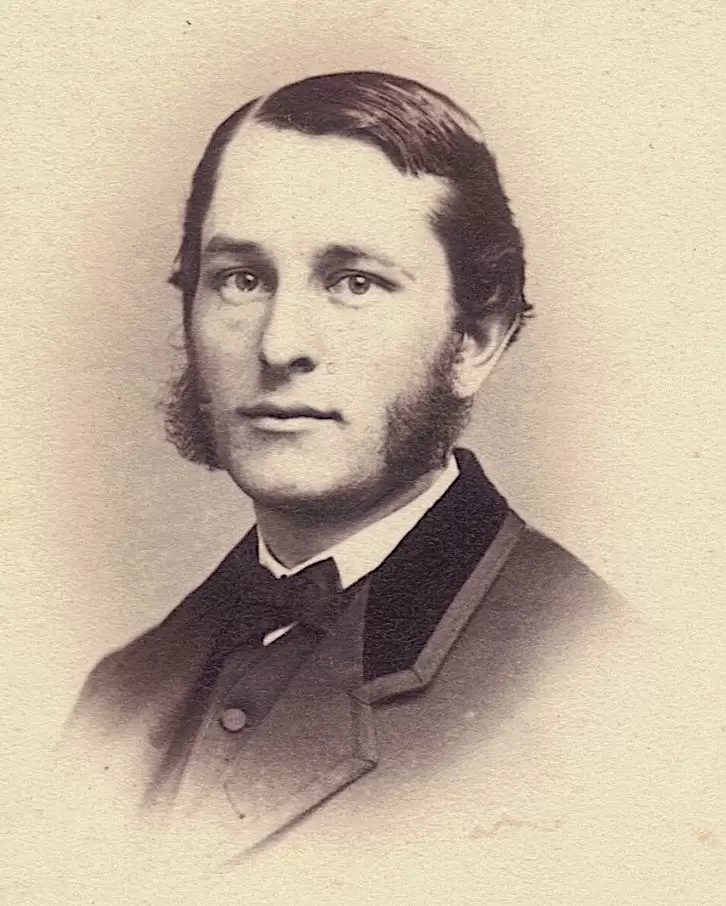
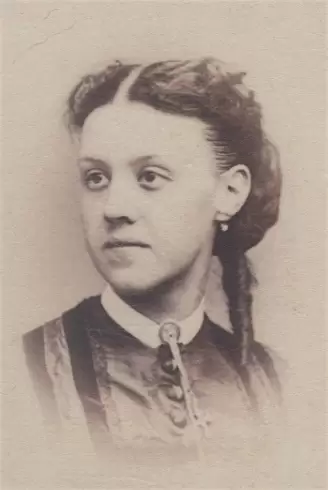


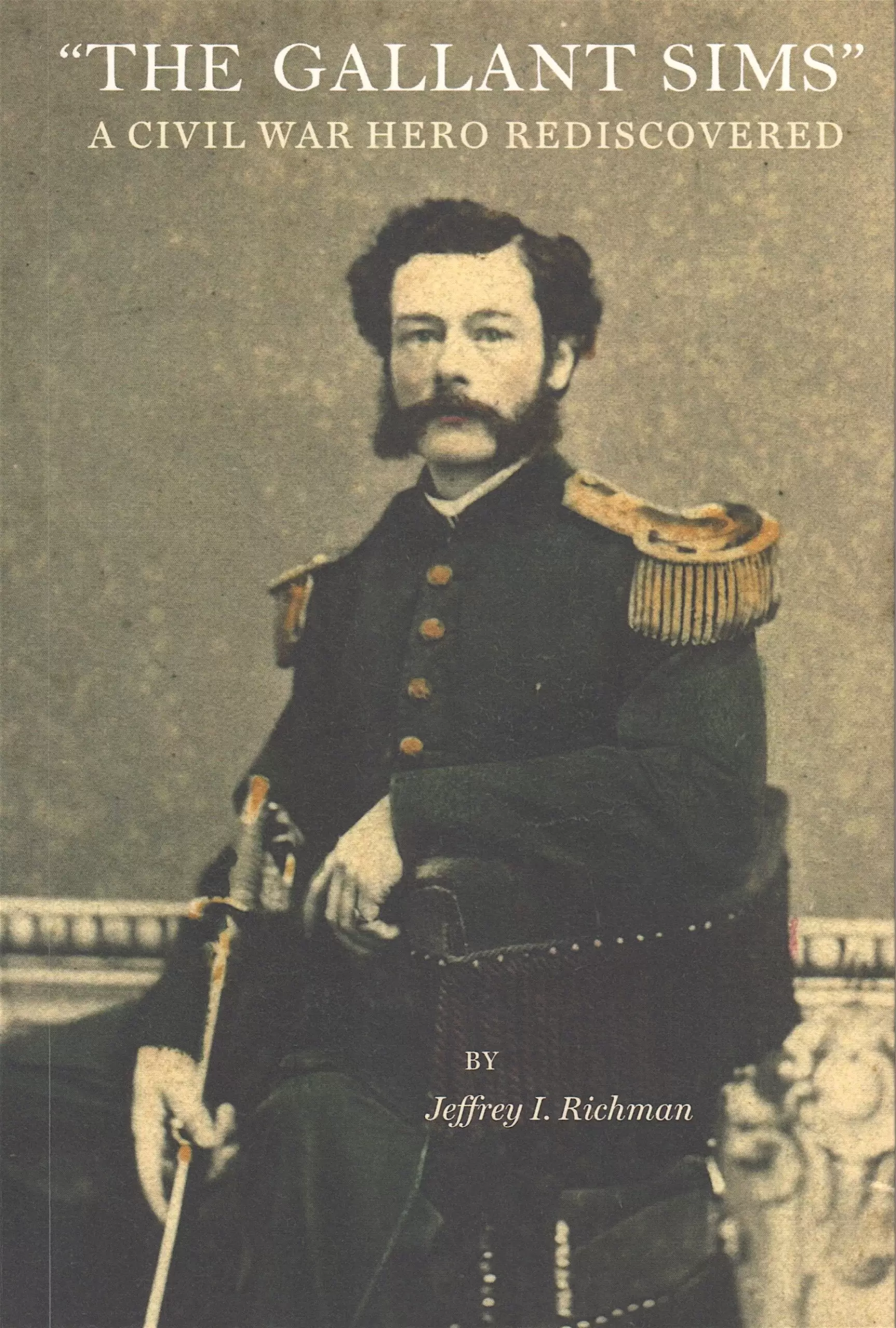


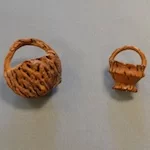

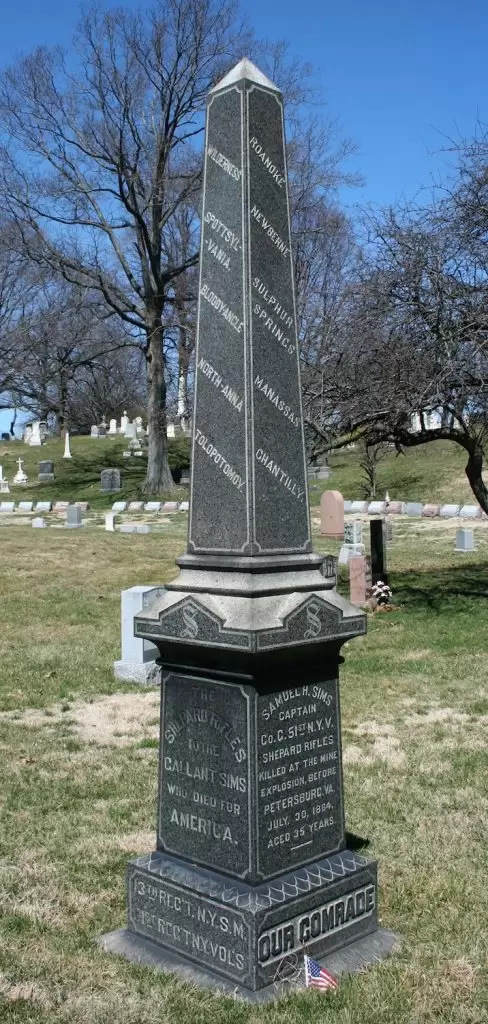
SIMS, WILLIAM GEORGE (1834-1911). Unknown soldier history. Sims was born in England. According to his obituary in The New York Times, he was a Civil War veteran. Further details are unknown. According to the census of 1870, he was a clerk in the Naval Stores House in Brooklyn. The 1888-1890 Brooklyn Directory listed Sims’ occupation as bookkeeper. He last lived in Brooklyn at 223½ Wyckoff Street. In 1911 he died from nephritis. Section 173, lot 21777.

SINCLAIR, GEORGE (1837-1869). Private, 5th New York Heavy Artillery. Sinclair enlisted on January 29, 1864, at New York City, and mustered into the 5th New York Heavy Artillery. His death was caused by phthisis. A Veterans Administration gravestone was ordered for him early in the 1900s. Section 115, lot 13536 (Soldiers’ Lot), grave 112.
SINCLAIR, JOHN (1819-1866). Private, 173rd New York Infantry, Company I. Originally from Scotland, Sinclair enlisted as a private on September 19, 1862, at New York City, mustered into the 173rd New York on November 10, and deserted from a ship in New York Harbor on December 15 of that year. His last residence was 20 Sackett Street in Brooklyn. He died from tuberculosis. Section 162, lot 14714.
SINGLETON, EBER (1834-1882). First lieutenant and quartermaster, Westchester Light Infantry. Of English birth, he enlisted at New York City on February 21, 1863, mustered into the Westchester (New York) Light Artillery as a first lieutenant and quartermaster two days later, and was discharged on June 20, 1863, when the regiment was consolidated. The unit was part of the 178th New York. He last lived on Second Avenue in Brooklyn. His death was caused by bronchitis. Section 15, lot 17263, grave 547.

SINGLETON, THOMAS (1844-1862). Corporal, 48th New York Infantry, Company E. Singleton, who was born in New York State, enlisted as a private at New York City on August 26, 1861, mustered into the 48th New York the next day, and was promoted to corporal of his company on an unknown date. On March 11, 1862, he drowned at Pine Island, South Carolina. He was buried at Green-Wood on October 28, 1862. Section 159, lot 13657.
SIPES, WILLIAM BARTON (1831-1905). Colonel, 7th Pennsylvania Cavalry; captain, 2nd Pennsylvania Infantry, Company I. Sipes was an editor as per the Philadelphia City Directory of 1859. During the Civil War, he enlisted as a captain and was commissioned into the 2nd Pennsylvania on April 20, 1861, and mustered out at Harrisburg, Pennsylvania, on July 26. He re-enlisted and was commissioned into the Field and Staff of the 7th Pennsylvania as lieutenant colonel on August 21, 1861, and rose to the rank of colonel on July 26, 1863. From December, 1863, to January 24, 1864, he commanded the First Brigade, Second Division, of the Cavalry Corps of the Army of the Cumberland. He commanded the post at Columbia, Tennessee, from June to November, 1864.
Colonel B. H. G. Minty, commanding officer, wrote from Salem, Tennessee, on July 29, 1863, and recognized Sipes as one who deserved special mention for the “promptness and manner in which he handled his command…” the previous month at Shelbyville on June 27. He resigned on November 30, 1864, because of “chronic dyspepsia, nervous debility induced by malarial disease, and irritability of the heart manifested on increased exertion.” In civilian life, Sipes was a newspaper editor, lawyer, and journalist. He lived in several Pennsylvania towns before moving to Bath Beach in Brooklyn. Section 205, lot 29071.


SISSON, JOHN R. (1832-1895). Private, 10th Regiment, Rhode Island Infantry, Company D. A resident of Coventry, Rhode Island, he enlisted on May 26, 1862, and mustered into Company D of the 10th Rhode Island Infantry. The 10th Regiment was assigned to guard the defenses of Washington, D.C., with Company D assigned to Fort DeRussy. He mustered out at Providence, Rhode Island, on September 1, 1862.
Sisson was living in Brooklyn according to the census of 1880. The Veterans Schedule of 1890 confirms his military service. His last residence was 479 Lexington Avenue in Brooklyn. Sisson died from cancer in 1895. Ella Sisson applied for and received a widow’s pension in 1902, certificate 686,805. Section 135, lot 14964, grave 343.

SISTARE, WILLIAM HENRY MAURICE (1842-1915). Adjutant, 102nd New York Infantry. Born in New York City to a wealthy banker, Sistare enlisted there as an adjutant on January 24, 1862, the same date that he was commissioned into the Field and Staff of the 102nd New York. He was discharged on May 10, 1863.
Sistare’s obituary in The New York Times, which confirmed his Civil War service and states that he was twice wounded, notes that in 1865, he became a member of the New York Stock Exchange and joined his father’s firm, George K. Sistare’s Sons, at 16 Broad Street. As per the New York City Directory of 1877, he was a broker. An article in The New York Times on April 13, 1887, reports that Sistare was in Detroit, Michigan, that day to straighten out affairs in the family’s branch office there where the manager was short $28,000, of which $7,200 was returned.
His business life was ultimately destroyed by another controversy. According to an article in the New York Evening Post on February 12, 1891, Sistare was arrested on charges of swindling $68,000 from August Hecksher of Philadelphia, Pennsylvania. A warrant for his arrest had been issued in December of 1890, but he evaded arrest until he appeared as a witness in a civil suit; he was apprehended as he left the courtroom. He then was taken to the Tombs Police Court. However, his obituary notes that in the spring of 1890, after Sistare had reorganized the Lackawanna & Western Railroad, his partner in Philadelphia fell ill and died. It was discovered that the partner had embezzled $300,000, and despite Sistare’s efforts, his father’s firm was forced to go out of business.
In 1897, Sistare’s application for an invalid pension was approved, certificate 1,084,223. He was a member of the Alexander Hamilton Post #182 of the G.A.R. For the last ten years of his life, Sistare was the custodian of Grant’s Tomb in New York City. His last residence was 549 Riverside Drive in Manhattan. He succumbed to stomach cancer. Section 94, lot 10873.

SKEAT, CHARLES (1834-1897). Corporal, 83rd New York Infantry, Company H. A native New Yorker, Skeat enlisted there as a private on May 27, 1861, and mustered immediately into the 83rd New York. On December 13, 1862, he was wounded at Fredericksburg, Virginia. He rose to corporal on about April 15, 1863, then, on April 15, 1864, was reduced in rank to private. He mustered out on June 23, 1864, at New York City.
In 1892, Skeat’s application for an invalid pension was granted, certificate 903,059. As per his obituary in the New York Herald, he was a Freemason and member of the Association of Exempt Firemen. He last lived at 355 West 16th Street in New York City. He died from apoplexy. Section 135, lot 14964, grave 109.
SKELLERN, CHARLES M. (1841-1890). Private, 37th Regiment, New York State National Guard, Company D; 10th Veteran Reserve Corps, Company B; 2nd Battalion Veteran Reserve Corps. Skellern enlisted as a private on May 29, 1862, at New York City, mustered into the 37th Regiment that day, and mustered out with his company at New York City on September 2. When his regiment was reactivated in 1863, he served in the same company for 30 days. He also served in the 10th Veteran Reserve Corps and the 2nd Battalion Veteran Reserve Corps. According to his father’s letter, written in 1864, he was wounded during his 1862 service and was at the Battle of Gettysburg, Pennsylvania, in 1863. In civilian life, he was a railroad brakeman. His death was attributed to fatty degeneration of the heart. Section 164, lot 16190.

SKELTON, ALONZO (1838-1908). First sergeant, 5th New York Veteran Infantry, Company G; corporal, 84th New York (14th Brooklyn) Infantry, Company H. Born in New York City and a sail-maker by trade, he enlisted as a private at Brooklyn on August 14, 1862, and mustered into the 14th Brooklyn that day. He had dark eyes, sandy hair, a light complexion, and was 5′ 8½” tall. He was promoted to corporal on July 1, 1863, and transferred into the 5th Veteran Infantry on June 2, 1864. After being promoted to first sergeant on March 1, 1865, he mustered out with his company on May 31, 1865, at Alexandria, Virginia.
As per his obituary in the Brooklyn Daily Eagle, Skelton was a member of the Fourteenth Regiment War Veterans Association and the Moses F. Odell Post #443 of the G.A.R.; members of both organizations were invited to attend his funeral. He last lived in Brooklyn. He died from nephritis. Section 15, lot 17263, grave 1330.
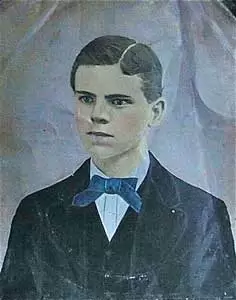
SKELTON, THADDEUS (1835-1889). Private, 84th New York (14th Brooklyn) Infantry, Company H. Serving in 1861, he enlisted at Brooklyn on April 18, mustered in on May 23, and was discharged for disability on September 24 at Arlington, Virginia. He was one of the Civil War Veterans honored with a wreath on his grave on Decoration Day, May 1890. He last resided at 203 York Street in Brooklyn. His death was caused by diarrhea. Section 117, lot 10975, grave 302.

SKIDMORE, BENJAMIN F. (1833-1866). Private, 152nd Ohio Infantry, Company G. Skidmore, who was born in New York State, enlisted on May 2, 1864, as a private. Six days later, he mustered into the 152nd Ohio and was discharged on September 2, 1864, at Camp Dennison, Ohio. His last residence was 37 East 4th Street in Manhattan. His death was attributed to “exhaustion.” Section 56, lot 1980.

SKILLEN, JOHN (1824-1864). Sergeant, 71st New York Infantry, Company H; 120th New York Infantry, Company F. Of Irish birth, he enlisted as a private at Brooklyn on August 28, 1862, and mustered into the 71st New York Infantry on that date. He was promoted to corporal (date unknown) and later to sergeant on June 1, 1864. On July 7, 1864, he was transferred into the 120th New York. Skillen was killed in battle at Fort Morton in Petersburg, Virginia, on November 7, 1864. Burial at Green-Wood took place on December 15, 1864. Section 23, lot 8312.

SKILLMAN, JOHN MOON (1831-1865). Acting assistant paymaster, United States Navy. A Brooklyn native, Skillman helped found Zeta Psi Fraternity when he was a student at New York University. Following graduation in 1849, he was employed by John B. Kitching & Co. He entered military service in the United States Navy before the onset of the Civil War. Skillman served as pay clerk on the USS Potomac from August 26, 1861-October 15, 1862, and as acting paymaster and captain’s clerk on the USS Bohio from November 14, 1862- February 12, 1864. He transferred to the USS Meteor and served on that ship as acting assistant paymaster until his death in 1865 at Mobile Bay, Alabama. A member of the First Dutch Church of Brooklyn, he was described as being very thoughtful, with a kind disposition, and “much esteemed by his employers.” Section 109, lot 2038.

SKILTON, JULIUS A. (1833-1897). Surgeon, 87th New York Infantry; 14th New York Cavalry; assistant surgeon, 30th New York Infantry. Originally interred at Green-Wood in lot 24317, Skilton was moved to lot 8839 on April 14, 1899, and removed to Oakwood Cemetery in Troy, New York, on May 7, 1918. After enlisting as an assistant surgeon at Albany, New York, on May 21, 1861, he was commissioned into the Field and Staff of the 30th New York on June 1. Upon his promotion to surgeon on January 16, 1862, he was commissioned that day into the Field and Staff of the 87th New York at Troy, New York.
Skilton was taken as a prisoner of war at Richmond, Virginia, on an unstated date, and was confined to Libby Prison in Richmond on June 15, 1862. On January 9, 1863, he was transferred into the 14th New York Cavalry, and was commissioned in as a surgeon on that day. Skilton was severely wounded on about April 15, 1864, at Monetti’s Bluff, in Cane River, Louisiana, and mustered out at New Orleans on June 12, 1865.
His application for an invalid pension was granted in 1866, certificate 119,000. As per his obituary in the New York Herald, Skilton was a member of the Lafayette Post #140 of the G.A.R.; members were invited to attend his funeral in citizen’s dress. He last lived at 444 Hancock Street in Brooklyn. His death was caused by asphyxia. Harriet Skilton applied for and received a widow’s pension in 1898, certificate 531,627.
SKINNER, CHARLES (1838-1862). Private, 83rd New York Infantry, Company L. Skinner was a native of New York City who enlisted there on September 9, 1861, and mustered immediately into the 83rd New York. He was killed in battle on December 13, 1862, at Fredericksburg, Virginia, and interred at Green-Wood on January 6, 1863. Originally interred in lot 4073, grave 709, his remains were moved to their present location on October 11, 1864. Section 188, lot 15212.
SKINNER, SAMUEL T. (1844-1889). Second lieutenant, 13th Regiment, New York State National Guard, Companies K, H, and G. He enlisted at Brooklyn as a private on May 28, 1862, mustered into Company K of the 13th Regiment that day, and mustered out with his company after three months on September 12. According to his obituary, he was transferred to Company H in 1865, and became the first second lieutenant of Company G, which was organized by Henry Ward Beecher (see), the well-known reverend of the Plymouth Church in Brooklyn. Company G was known familiarly as the “Beecher” or “Plymouth Company.” Skinner served with his unit after the War until his discharge on May 10, 1878. His last residence was 147 Lefferts Place in Brooklyn. His death was caused by phthisis. Section 147, lot 25451.
SLADE, JOHN H. (1842-1862). Unknown soldier history. Originally interred at Green-Wood in lot 8082, his remains were removed from the cemetery in March 1869. A native of Virginia, Slade was killed in battle in Maryland on September 18, 1862. The details of his service are not known.
SLINGERLAND, GEORGE W. (or O.) (1835-1923). Private, 125th New York Infantry, Company D; Veteran Reserve Corps. Slingerland enlisted as a private at Troy, New York, on August 6, 1862, and mustered into the 125th New York on August 27. He was taken as a prisoner of war at Harper’s Ferry, Virginia, on September 15, 1862, and paroled there the next day. On or about January 1, 1864, he transferred into the Veteran Reserve Corps from which he was discharged on March 7, 1864. He last lived at 223 11th Street in Brooklyn. He succumbed to heart disease. Section 194, lot 31437, grave 2.
SLIPPER, JOSEPH AUGUSTUS (1841-1882). Colonel, lieutenant colonel, and major by brevet; captain and assistant adjutant general, United States Volunteers; first lieutenant, 67th New York Infantry. Born in New York City, Slipper graduated from Columbia College and was a schoolteacher in Manhattan before his enrollment. He enlisted as a first lieutenant on September 16, 1861, and served in that capacity with the 67th New York. On September 9, 1862, he became captain and assistant adjutant general of United States Volunteers, serving with the Army of the Potomac. He was brevetted major of United States Volunteers on March 13, 1865, “for faithful and meritorious service during the War,” and brevetted lieutenant colonel and colonel of Volunteers on the same date for “gallantry and meritorious service in the field during the War.”
At the close of the War, he was a journalist, editing the Army and Navy Journal and serving on the editorial staff of Hearth and Home. He later owned a book and printing establishment, Messrs. Macgowan & Slipper, at 30 Beekman Street and was an active member of the G.A.R. The New York City Directory of 1877 lists him as a printer. According to his obituary in The New York Times, he developed spinal trouble during his time in the army that plagued him for the last five years of his life and eventually caused his death. Slipper also suffered from typhoid fever and pneumonia during his service, and returned home in poor health. At the time of his death, he resided at 457 Henry Street in Brooklyn. Zillah J. Slipper applied for and received a widow’s pension in 1887, certificate 239,816. Section 192, lot 23925.

SLOAN (or SLOANE), SAMUEL (1827-1866). Private, 79th New York Infantry, Company H. Born in New York, Sloan enlisted at New York City as a private on May 13, 1861, mustered into his company on May 28, and deserted on July 22, 1862, at Newport News, Virginia. He last resided at 280 Broome Street in Manhattan. Section 167, lot 20113.
SLOAT, JOHN D. (1833-1875). Private, 3rd New York Light Artillery, Battery C. A Connecticut native, Sloat enlisted as a private at Western, New York, on September 17, 1864, mustered into the 3rd New York Light Artillery that day, and mustered out at Syracuse, New York, on July 14, 1865. He last lived in New York. Section 151, lot 16136.
SLOAT, JOHN DRAKE (1781-1867). Rear admiral, United States Navy. Born at the family home in Sloatsburg, New York, he was orphaned at an early age, and raised by his maternal grandparents. He enlisted in the Navy in 1800, but was discharged shortly thereafter by the Peace Establishment Act. Sloat re-entered the Navy in 1812, served aboard the frigate United States under Commodore Stephen Decatur from 1812 until 1815, taking part in the capture of the British frigate Macedonian, fought pirates in the West Indies in the 1820s, and served as a commandant of the Portsmouth (New Hampshire) Navy Yard from 1840-1844.
Sloat then commanded the Pacific Naval Squadron, and in 1846, in an action later described by the Secretary of the Navy as “ably conceived and brilliantly executed,” he landed a detachment of marines, captured Monterey and San Francisco (then called Yerba Buena), claimed California for the United States, and raised the American flag there for the first time on July 7. Sloat was military governor for seven days before handing the office to Robert Stockton. He was given command of the Norfolk Navy Yard in 1847, when poor health made him stay ashore, and held that post until 1851.
Although Sloat was placed on the Navy reserve list in 1855, he advised the Navy Department during the Civil War, was promoted to commodore in 1862 and to rear admiral on August 6, 1866. Sloat was a Freemason. He died of paralysis at home in New Brighton, Staten Island. A statue to his memory was unveiled at the Presidio in Monterey, California, in 1910. In addition, two destroyers have been named the USS Sloat in his honor and streets in San Francisco, Monterey and Sacramento, California, bear his name. Section 151, lot 16136.
SLOCOMB (or SLOCUM), EDWIN (or EDWARD) HASKIN (1836-1926). First sergeant, 11th New York Infantry, Companies C and G. A native New Yorker, Slocomb enlisted there as a private on April 20, 1861, and mustered into Company C of the 11th New York on May 7. He transferred into Company G on October 11, 1861, was promoted to sergeant, and became a first sergeant on January 1, 1862. He mustered out on June 2, 1862, at New York City. He last resided on East 9th Street in Plainfield, New Jersey. His death was attributed to chronic myocarditis. Section 20, lot 4412.
SLOCUM, HENRY WARNER (1827-1894). Major general, United States Volunteers; colonel, 27th New York Infantry. Born in Delphi, New York, Slocum graduated from the United States Military Academy in 1852, 7th in his class, and saw action in Florida during the Seminole War. Subsequently, he saw duty at Fort Moultrie, South Carolina. He resigned in 1856 to practice law in Syracuse, New York, and served as county treasurer, state legislator, and colonel and artillery instructor in the State Militia.
When the Civil War began, Slocum was appointed colonel of the 27th New York, was severely wounded by a musket ball in the right thigh at First Bull Run, Virginia, and went home on sick leave from July 22-September 10, 1861; his regiment suffered 130 casualties at Bull Run. He was commissioned brigadier general of volunteers in August 1861, returned to action in September, and was made major general in July 1862. He fought at Second Bull Run, Virginia; South Mountain and Antietam, Maryland; and Chancellorsville, Virginia.
In October 1862, Slocum took command of the 12th Army Corps after Joseph Mansfield was killed at Antietam. He commanded the extreme right flank of the Union Army (the point of the fishhook on Culp’s Hill) at Gettysburg, Pennsylvania. When his XII Corps was sent to join the Army of the Tennessee under General Joseph Hooker, Slocum, who had been angry at Hooker since Chancellorsville, offered his resignation. However, it was refused, and Slocum was given the command of the District of Vicksburg.
In 1864, he took command of the Army of Georgia, a combination of Slocum’s 20th Army Corps and the 14th Corps, and joined Major General William T. Sherman for the March to the Sea. After Slocum was given command of the Army of Georgia, he was given a presentation sword, created by Tiffany & Co. That sword, with a 32″ double-edged blade had 17″ etched panels, fluted solver grip and German silver scabbard; the sword was engraved, “PRESENTED TO MAJ GENL. H. W. SLOCUM COM’D ARMY OF GEORGIA FROM THE MEMBERS OF HIS STAFF.” It was Slocum’s men who were the first Union troops to enter Atlanta, Georgia. He resigned his commission in September 1865, and returned to Brooklyn.

A lawyer, Slocum was elected to Congress three times (1868, 1870, 1882), served as the president of the Brooklyn Board of City Works, and was a member of the Gettysburg Monument Commission. He was also a member of the board of trustees of the Brooklyn Bridge, and campaigned to make its use free to the public. He took an active part in the defense of General Fitz John Porter (see), delivering a speech in Congress in 1884 urging his exoneration twenty years after Porter was found guilty by court-martial.
He served as president of the Coney Island and Brooklyn Railroad Company and the Brooklyn Club, and was a founder of the Soldiers’ Home in Bath, New York, where he served as a president of the Board of Trustees until 1894. The G.A.R. Post #28 was named in his honor. The steamboat General Slocum, named for him, burned in the East River in 1904, with over 1,000 deaths. Slocum’s death was caused by pneumonia. In 2018, the aforementioned presentation sword which was given to Slocum when he took command of the Army of Georgia in 1864 was offered for sale by the Horse Soldier, a store that sells military memorabilia. Section 139, lot 28760.



SMALL, ALEXANDER (1842-1879). Private, 83rd New York Infantry, Company F. Small, a native of New York City, enlisted there on September 30, 1861, and mustered into the 83rd the next day. He deserted on May 15, 1863, returned to service on April 15, 1864, deserted again the next month on May 7, and was apprehended eight days later. On June 25, 1864, he was dishonorably discharged at Philadelphia, Pennsylvania. He last lived at 422 Hart Street in the Flatbush section of Brooklyn. His death was caused by general paralysis. Section 13, lot 10943.
SMALL, CHARLES (1838-1895). First quartermaster, 162nd New York Infantry, Company I. Small enlisted as a private and mustered into Company I of the 162nd New York. At some point, he was promoted to first quartermaster and transferred into the Field and Staff. Further details of his military record are not known. He was a member of the Henry M. Lee Post #21 of the G.A.R. His last residence was 431 Berry Street in Brooklyn. Small succumbed to liver cancer. Section 13, lot 25675.
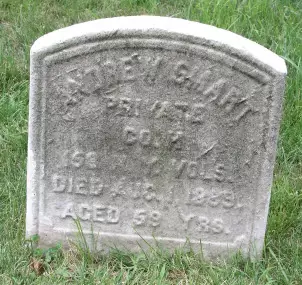
SMART, ANDREW (1826-1889). Private, 158th New York Infantry, Company H. A native of Scotland, Smart enlisted as a private at Brooklyn on August 22, 1862. The following September 3, he mustered into the 158th New York. He is listed as having been wounded, with no date or place given, and was discharged on October 2, 1864.
Smart applied for but apparently did not receive an invalid pension. He last lived on Van Brunt Street in Brooklyn. His death was caused by asthenia, a muscle disease. Catharine Smart applied for and received a widow’s pension in 1891, certificate 357,551. Section 6, lot 20118, grave 423.
SMILEY, DAVID A. (1844-1865). Corporal, 69th New York Infantry, Company H. Born in Nova Scotia, Canada, Smiley was living at 14 North 8th Street in Williamsburg, Brooklyn, when he enlisted. He was 5′ 4¾”, with a dark complexion, brown hair and gray eyes. He enrolled as a substitute with the rank of private at Brooklyn on September 1, 1864, mustered into the 69th two days later, and was promoted to corporal on February 5, 1865. On March 25, 1865, he suffered a gunshot wound at Fort Stedman, Virginia, that fractured his left thigh, and was taken to Armory Square Hospital, Washington, D.C., where he died on April 17, 1865. His personal effects at the time of his death were one cap, one pair of trousers, two blouses, and a pocketbook with $25 in banknotes, a handkerchief and sundries. Section 122, lot 10975, grave 751.

SMITH, ADOLPHUS P. (1835-1903). Private, 7th Massachusetts Infantry, Company H; 5th United States Army Light Artillery, Battery H. Born in Denmark and a resident of Rockaway, New York, he enlisted on June 15, 1861, and mustered into the 7th Massachusetts Infantry. On January 21, 1863, he was discharged and mustered into the 5th United States Light Artillery, serving until his discharge on June 15, 1864. At the time of his death from pancreatic cancer, he was a resident of the New York State Soldiers’ Home in Bath, New York, having previously lived on Dyckman Street in Brooklyn. Section 86, lot 31217, grave 118.
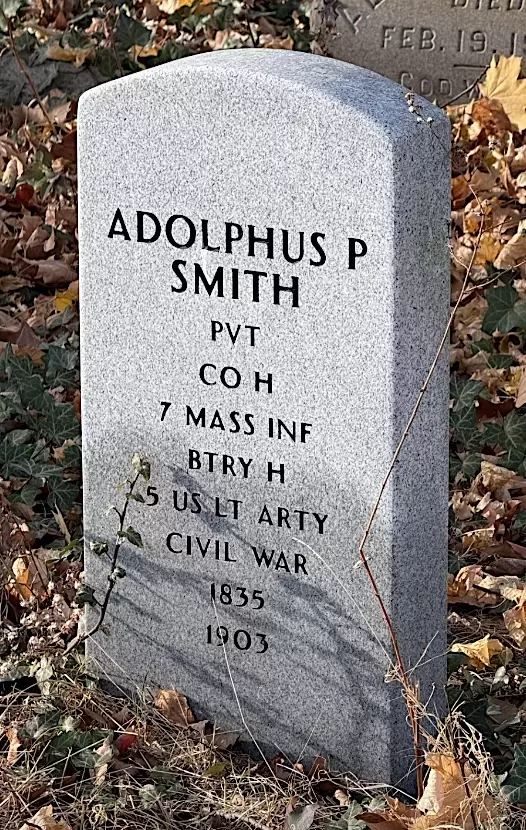

SMITH, ALBERT (or ABEL) (1834-1901). Private, 13th Regiment, New York State Militia, Company B. Smith served for three months in the 13th New York State Militia in 1861, enlisting at Brooklyn on April 23, mustering in on May 17, and mustering out on August 6 at Brooklyn. His last residence was in Norwalk, Connecticut, where he died of paralysis. Section 103, lot 4583, grave 10.
SMITH, ALBERT G. (1840-1870). First lieutenant and quartermaster, 56th Regiment, New York State National Guard. Serving for 30 days, he enlisted and was commissioned into the 56th New York’s Field and Staff as a first lieutenant on June 18, 1863. He was promoted to quartermaster and first lieutenant that same day, and mustered out on July 24 at Brooklyn. He last lived in the Flatbush section of Brooklyn where he died from “intemperance.” Section 150, lot 14170.

SMITH, ALEXANDER (or ALEX) WARREN (1830-1886). Captain, 35th New York Infantry, Company D; 53rd New York Infantry, Company H; 132nd New York Infantry, Company K. He enlisted as a captain at Yorkville, New York, on May 13, 1861, was commissioned into the 35th New York on June 11, and resigned on January 17, 1862. He re-enlisted at New York City on May 12, 1862, as a first lieutenant, mustered into the 53rd New York (second organization) on July 28, and was promoted to captain on August 14. Smith was transferred on September 10, 1862, into the 132nd New York from which he was discharged on August 24, 1864. His last address was 62 St. Felix Street in Brooklyn. Section 45, lot 5271.
SMITH, ALONZO A. (1838-1871). Corporal, 122nd New York Infantry, Company G. Born in New York State, Smith enlisted on August 8, 1862, at Jordan, New York, as a private, and mustered into the 122nd seven days later. He was promoted to corporal of his company on or about March 15, 1863. He deserted on July 1, 1863, on the march to the Battle of Gettysburg, Pennsylvania. Section 175, lot 19876.

SMITH, ANDREW HEERMANCE (1837-1910). Major and captain by brevet; surgeon, 43rd New York Infantry; 94th New York Infantry; assistant surgeon, United States Army Medical Staff. Born in Charlton, New York, Smith was educated at the Ballston Spa Institute, Union College, the College of Physicians and Surgeons and the Universities of Goettingen and Berlin in Germany. During the Civil War, he enlisted as an assistant surgeon on December 14, 1861, was immediately commissioned into the 43rd New York, and was discharged for promotion on May 10, 1862. The next day, he was promoted to surgeon and commissioned into the 94th New York effective May 31. He was made assistant surgeon in the United States Army on July 17 of that year, was promoted by brevet to captain and major on March 13, 1865, and served in the military until his resignation on April 24, 1868.
After his discharge from the Army, Smith practiced medicine in New York City for 39 years and wrote numerous medical books. He last lived in Geneva, New York, but died of myocarditis at the Algonquin Hotel at 59 West 44th Street in New York City. As per his obituary in the New York Tribune, which confirmed his Civil War service, Smith was the owner of the Algonquin Hotel but was not involved in its management. In addition, he belonged to medical societies in the United States and Europe, and was a member of various fraternal organizations including the Sons of the American Revolution, the Century Club, and the Loyal Legion, a patriotic association. His gravestone states he served in the 93rd New York Volunteers, but that is incorrect–it was the 43rd and the 94th. Section 66, lot 981.
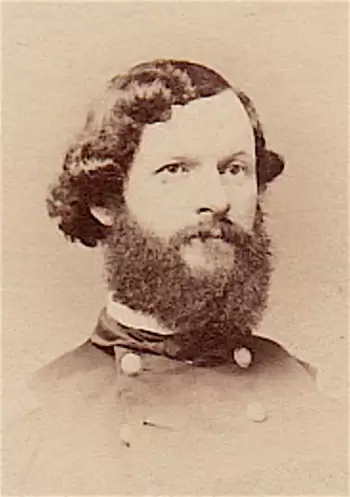
SMITH, BERNARD (1844-1909). He was either a private, 25th New York Infantry, Company E, or private, 10th New York Infantry, Companies C and D. He was born in Sweden. If he served in the 25th, he enlisted at New York City on April 19, 1861, and mustered into the 25th New York on June 14. He was taken twice as a prisoner of war, first on June 27, 1862, at Chickahominy, Virginia, and paroled on August 5 at Aiken’s Landing, Virginia. Later that month on August 30, he was taken prisoner at the Battle of Second Bull Run, Virginia, and paroled on December 17, 1862, at an unstated place. Smith mustered out on July 10, 1863, at New York City.
If he was the Bernard Smith who served in the 10th, he enlisted at New York City on August 20, 1862, and mustered into Company C of the 10th New York the next day. He was transferred into Company D on April 27, 1863, and mustered out on June 8, 1865, at Munson’s Hill, Virginia. He last lived on Broadway in Brooklyn where he died of nephritis. Section 5, lot 18002.
SMITH, BERNARD N. (1838-1910). Captain, 169th New York Infantry, Companies A and B; private, 44th New York Infantry, Company C. After enlisting at Albany, New York, as a private, Smith mustered into Company C of the 44th New York on October 5. He was wounded at Hanover Court House, Virginia, on May 27, 1862. He re-enlisted as a second lieutenant for three years at Troy, New York, on August 21, 1862. He was discharged from the 44th for promotion on September 22, 1862, at which time he was commissioned into Company A of the 169th New York. He was promoted to first lieutenant on December 4, 1862, and simultaneously transferred to Company B. Smith was promoted to captain on May 10, 1864, and mustered out on July 19, 1865, at Raleigh, North Carolina.
In 1884, Smith’s application for an invalid pension was approved, certificate 284,493. He last lived at the Hotel Regent on Broadway and 71st Street in Manhattan. In 1916, his wife applied for and received a widow’s pension, certificate 883,037. Section 166, lot 25571, grave 1.


SMITH, CHARLES B. (1840-1905). Second lieutenant, 22nd Regiment, New York State National Guard, Company I. Born in Buffalo, New York, he enlisted at New York City, was commissioned into the 22nd Regiment on May 31, 1862, and mustered out after serving three months on September 5. As per his obituary in the New York Herald, he was a member of the G.A.R. Smith died of “la grippe” in South Pines, North Carolina, but last resided at 971 Herkimer Street in Brooklyn. Section 99, lot 8965.

SMITH, CHARLES H. (1847-1892). Musician, 117th New York Infantry, Company A. Smith, who was born in New York, enlisted as a private at Utica, New York, on July 28, 1862, mustered into the 117th New York on August 8, and mustered out on June 8, 1865, at Raleigh, North Carolina. During his service, he was a musician for his regiment.
In 1891, Smith’s application for an invalid pension was granted, certificate 709,261. At the time of his death, he lived at 9 Webster Place in Brooklyn. An inscription on his tombstone notes the regiment number and its Utica connection. Smith death was recorded as “hepatic,” which is a buildup of toxins in the brain. Hattie Smith, who is interred with him, applied for and received a widow’s pension in 1892, certificate 338,788. Section 200, lot 27913, grave 2.
SMITH, CHURCHILL (1841-1885). Private, 10th United States Colored Troops, Heavy Artillery, Company B. Smith, who was born in Newtown, Long Island, enlisted in 1863. He mustered into Company B, 10th United States Colored Troops (USCT), Heavy Artillery, that year. (At that time, the designation was the Corps D’Afrique.) Privates in the USCT were African-American. His last residence was 84 Ryerson Street in Brooklyn. His name appears on the African American Civil War Memorial in Washington, D.C., plaque A-22. Section 86, lot 2205, grave 78.

SMITH, DAVID (1834-1915). Company sergeant, 13th Regiment, New York State Militia, Company B. A native of New York, he enlisted at New York City as a private in 1861 and served three months in Company B of the 13th Regiment’s State Militia. When the regiment was reactivated in 1863 and part of the 13th National Guard, he re-enlisted as commissary sergeant, was assigned to the Field and Staff, and served from June 18-July 21. In 1891, he applied for and was granted an invalid pension, certificate 812,088. He last resided at 30 Fort Greene Place in Brooklyn. Annie H. Smith’s application for a widow’s pension was approved in 1915, certificate 795,165. Section 207, lot 31975, grave 4.
SMITH, EBENEZER (1829-1869). Sergeant, 5th New York Infantry, Company C. A New York State native, he enlisted at New York City as a private on April 25, 1861, and mustered into Company C of the 5th New York on May 9. On July 15, 1862, he was promoted to corporal of his company and then became its sergeant on February 12, 1863. He mustered out on May 14, 1863, at New York City. His last residence was 63 Ridge Street in Manhattan. He succumbed to anaemia. Section 164, lot 16465.
SMITH, EDGAR (1843-1869). Private, 5th New York Heavy Artillery, Company A. A native New Yorker, he enlisted at Brooklyn as a private on January 20, 1862, mustered into the 5th Heavy Artillery the next day, and deserted on May 18, 1862, at Fort Richmond, New York Harbor. At the time of his death from gastro enteritis, he lived at 752 West 29th Street in Manhattan. Section 86, lot 2205, grave 25.
SMITH, EDWARD B. (1819-1864). Sergeant, 3rd Vermont Infantry, Company I. A resident of Guildhall, Vermont, he enlisted as a sergeant on June 1, 1861, and mustered into the 3rd Vermont on July 16. He re-enlisted on December 21, 1863, and died of wounds received in battle in 1864 at Wilderness, Virginia. He was interred at Green-Wood on October 12, 1864. Section 44, lot 3698.

SMITH, EDWARD MONTAGUE (1840-1920). Sergeant, 13th Regiment, New York State National Guard, Company B. After enlisting as a corporal at Brooklyn on May 28, 1862, Smith mustered that day into the 13th New York Heavy Artillery, and mustered out at Brooklyn after three months on September 12 with the rank of sergeant. He re-enlisted and served as a sergeant with the 13th when the regiment was reactivated for 30 days in 1863.
Smith continued in the 13th National Guard serving for 24 years until 1884 and attaining the rank of captain. His Civil War service was confirmed by the 1890 Veterans Schedule. According to his obituaries in The New York Times and the New York Sun, he was active in Republican politics in the Fourth Ward in Brooklyn. Early in his career, he was in the surgical dressings business but then was employed in real estate for 20 years. In 1907, his pension application was approved, certificate 1,135,365. He last lived at 257 Halsey Street in Brooklyn. Shortly after his death from pneumonia, Mary Smith applied for and received a widow’s pension, certificate 885,257. Section H, lot 17344.


SMITH, FRANK K. (1838-1891). Major, 127th New York Infantry, Company D; sergeant, 7th Regiment, New York State Militia, Company D. A native of New York City, Smith, who was 5’9½” tall, joined the New York State Militia’s 7th Regiment in 1857. When the Civil War broke out, he enlisted on April 17, 1861, mustered into the 7th Regiment as a private, and mustered out with his company on June 3. He returned to serve in the 7th when it was reactivated a year later as part of the New York State National Guard. He re-enlisted on May 25, 1862, mustered into the same company as a sergeant on June 19, and was discharged for promotion on July 18, 1862.
After working to raise a company of recruits, Smith re-enlisted as a captain on August 26, 1862, at New York City, and was commissioned into the 127th on September 10. During the winter campaign of 1862-63, the regiment was encamped at Falls Church and Clouds Mills, Virginia, where they opposed cavalry raids and troop movements of General Longstreet. Captain Smith was attached to General George H. Gordon’s division, operating in the West Point, Virginia, area, and saw action at the Battle of the Peninsula. He led a campaign against General Lee’s communications at White House Landing, Virginia, and was subsequently ordered by General Meade to Hagerstown, Maryland. The 127th was attached to the Army of the Potomac until July 25, 1863, when they were ordered to Folly Island, South Carolina, to reinforce General Gillmore in operations in the area of Charleston, South Carolina. Brigadier General A. Schimmelfennig, his commanding officer, wrote to Captain W. L. M. Burger at headquarters on May 8, 1864, requesting an additional supply of Hale’s war rockets and asked that Captain Smith be given permission to head North for the ammunition. He wrote that Smith was “…thoroughly acquainted with the different varieties of the projectile…”
On December 6, 1864, Smith received a flesh wound, the bullet passing through his upper left arm at Deveaux’s Neck, South Carolina. Two days later, Lieutenant Colonel Stewart L. Woodford wrote in his field report from South Carolina that in spite of Smith’s being shot in the left arm early in the fight, “he remained upon the field with me until all was over…” He was promoted to major for “gallant conduct in the field and many meritorious actions,” although not mustered, on March 5, 1865, and was placed in command of the Northern District of the Department of the South where he was in charge of railroads. He mustered out of service on July 4, 1865, at Charleston, South Carolina.
After the war, Smith worked as a bank teller. An affidavit filed by his wife in 1892 stated he was also injured by his horse falling on him while on duty at Charleston, resulting in a stiff leg and his returning from the War on crutches. This debility, she claimed, caused him to fall under a Long Island Railroad train in July 1869 when the train started in motion while he was attempting to board. A wheel passed over his foot, crushing it so severely it had to be amputated. In 1887, his application for an invalid pension was granted for ¼ disability resulting from his service wound, certificate 387,115. His last residence was 533 Nostrand Avenue in Brooklyn. He died of heart failure. Elizabeth Smith, who is interred with him, applied for and received a widow’s pension in 1891, certificate 346,297. Section 120, lot 2541.

SMITH, GEORGE I. (1839-1871). Private, 2nd New York Cavalry, Companies H and D. On September 13, 1862, Smith enlisted as a private at New York City and mustered into Company H of the 2nd New York Cavalry that day. Taken as a prisoner of war on October 11, 1863, at Culpepper, Virginia, he was confined at Richmond, Virginia, on October 20, 1863, taken to Andersonville, Georgia, on February 6, 1864, and hospitalized on June 11 of that year. He was transferred to Company D on August 29, 1864, from which he was discharged. Smith last resided at 1542 Atlantic Avenue in Brooklyn. He succumbed to consumption. Section 151, lot 16198.
SMITH, GEORGE W. (1828-1899). Sergeant, 139th New York Infantry, Company K. Born on Long Island, Smith enlisted as a private on August 30, 1862, at Brooklyn. On September 9, he mustered into Company K of the 139th New York and was promoted to sergeant on an unknown date. After suffering a severe wound to the right elbow at Chaffin’s Farm, Virginia, on September 29, 1864, he was discharged for wounds on April 18, 1865. In May 1865, he applied for and received an invalid pension, certificate 49,232. He was a member of the Brooklyn Letter Carriers’ Association, the Ivanhoe Lodge, I.O.O.F., and the Moses F. Odell Post #443, G.A.R. He last resided at 440 State Street, Brooklyn. His widow applied for and received a pension after his death from rheumatism, certificate 488,101. Section 190, lot 18085, grave 2.
SMITH, GEORGE W. (1830-1880). Major, 11th New York Cavalry, Companies F and L. He enlisted as a second lieutenant on April 24, 1862, and was commissioned into Company F of the 11th New York Cavalry on that date. On October 30, 1862, he was promoted to first lieutenant, but not commissioned, and transferred on that date to Company L, later rising to the rank of captain on February 8, 1863. In his field report from Germantown, Tennessee, on April 19, 1865, Smith asked for reinforcements, noting that, “Those of our men who were killed or wounded were robbed of everything, they (the rebels) taking the boots from some of the dead…” He went on to ask for 50 mounted men from the regiment’s headquarters in Memphis and 100 additional soldiers “…to operate against these guerrillas to advantage, as I have reliable information concerning their haunts.” He was promoted to major on May 17, 1865, transferred from Company L to the Field and Staff on June 6, 1865, and mustered out on September 30, 1865, at Memphis, Tennessee. He last resided in Cleveland, Ohio where he died of paralysis. Section 69, lot 11775.
SMITH, GILBERT (1827-1867). Private, 87th New York Infantry, Company A; 40th New York Infantry, Company A. A native of New York State, Smith enlisted at New York City as a private on January 17, 1862, and mustered into the 87th New York on that date. On September 6, 1862, he transferred into the 40th New York from which he was discharged. His last address was on Waverly Place in Manhattan. His death was attributed to hemorrhage of the bowels. Section L, lot 17406.

SMITH, GUSTAV (1840-1902). Private, 65th New York Infantry, Company D. Enlisting as a private at New York City on April 3, 1865, Smith mustered into the 65th the same day, and mustered out at Hall’s Hill, Virginia, on July 17, 1865. He last resided at 143 34th Street in Brooklyn. His death was attributed to pneumonia. Section 206, lot 27211, grave 155.
SMITH, HEMAN (or HERMAN) P. (1842-1921). Second lieutenant, 1st Maine Heavy Artillery, Company B; corporal, 18th Maine Infantry, Company B. Born in Maine and a resident of Orrington there, he enlisted as a corporal on October 1, 1862, mustered into the 18th Maine on that date, arrived at Camp Stetson on October 13, and was transferred into the 1st Maine Heavy Artillery on December 19, 1862. After a promotion to sergeant February 1, 1863, he rose to first sergeant at some point in 1864. He was wounded at the Battle of Petersburg, Virginia, on June 6, 1864, and spent a year recuperating at the hospital. Smith’s obituary in the New York Tribune notes that at Petersburg, he led 800 troops and came out with only 200. Smith became a second lieutenant the next month on July 27and was discharged for wounds on August 21, 1865. In 1865, his application for a pension was granted.
After the war, Smith moved to Brooklyn where he was a publisher and a past commander of the Grant Post #327 of the G.A.R. His obituary, which refers to him as Colonel Smith, notes that he had been superintendent of the Sunday school at the Park Slope Congregational Church for thirty years. His last address was 481 1st Street in Brooklyn. As per his obituary, he was seated with family members when he experienced chest pain and died almost immediately. He was survived by a son and four grandchildren. Section 142, lot 29682, grave 6.


SMITH, HENRY DAVID (1834-1918). Recruiting officer, 13th Regiment. Smith, who was born in England, immigrated to the United States in 1852 and was a tobacco manufacturer in New York City. According to his New York Times obituary, he served during the Civil War as recruiting officer of the 13th Regiment of Brooklyn. After the War, he was in charge of the real estate department of numerous New York City newspapers including The World, The Tribune, The Evening Mail, and Commercial Adviser. He last resided at 576 McDonough Street in Brooklyn. Smith died of arteriosclerosis. Section 59, lot 309.

SMITH, HENRY E. (1835-1909). Private, 8th Regiment, New York State Militia, Company I. Smith, who was born in Philadelphia, Pennsylvania, enlisted at New York City in 1861. He served with the 8th Regiment when it was activated that year for three months and mustered out with his company at the expiration of his enlistment. In 1892, he applied for and was granted an invalid pension, certificate 861,176. His last residence was 1120 Fox Avenue in the Bronx. Smith died of valvular cardiac disease. In 1910, his widow applied for and received a pension, certificate 697,549. Section 13, lot 9300, grave 7.
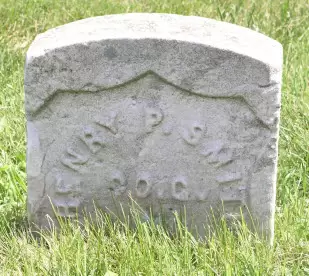
SMITH, HENRY P. (1841-1905). Private, 37th Regiment, New York State National Guard, Companies G and A. A native of Ireland, he enlisted and mustered into the 37th on May 29, 1862, at New York City. He mustered out after three months on September 2 at New York City.
Smith received an invalid pension in 1899, certificate 1,004,107. His last residence was 945 College Avenue in the Bronx. His death was attributed to pleurisy. Anna Smith, who is interred with him, applied for and received a widow’s pension in 1905, certificate 596,799. Section 135, lot 27263, grave 933.
SMITH, HIMAN (1842-1904). Rank unknown, 22nd Regiment, New York State Militia, Company G; 13th New York Infantry, Company C. Smith was born in Brooklyn. According to his pension index card, he served in Company G of the 22nd Regiment and in Company C of the 13th New York. Further details are unknown. He was a member of the George C. Strong Post#534 of the G.A.R., joining on October 23, 1897. In 1892, he applied for a pension, application 1,129,296, but there is no certificate number. He last lived at 163 Beech Street in Flushing, New York. His death was caused by cystitis. Section 44, lot 3699, grave 10.
SMITH, HIRAM (or HARRY) D. (1837-1885). Second lieutenant, 17th New York Light Artillery. Smith was born in Medina, New York, and was listed as living with his parents on the census of 1850. After enlisting as a second lieutenant at Medina, New York, on August 26, 1862, Smith immediately mustered into the 17th Light Artillery where he commanded the 3rd and 4th guns. He participated in the surrender of Confederate General Robert E. Lee. He mustered out on June 12, 1865, at Richmond, Virginia.
In 1865, Smith was listed as a confectioner and baker on the census of Ridgeway, New York; the 1870 census reports that he was a grocer and listed him as H. D. Smith. He moved to Woodside, New York, in 1885, and was listed as chief salesman of the Hamilton Rubber Company of Trenton, New Jersey. News articles in The New York Times on December 30, 1885, and the Medina Tribune on January 7, 1886, report that he was found in front of 103 West 28th Street with a fractured skull and never regained consciousness. He died at New York Hospital. Section 3, lot 18372, grave 147.

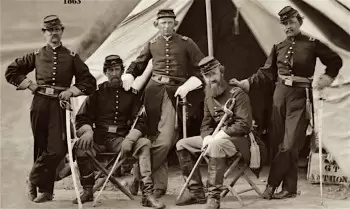
SMITH, HIRAM G. (or C.) (1838-1891). Private, 8th Regiment, New York State Militia, Company B. Smith, who was born in New York State, enlisted as a private at New York City in 1861. He mustered into Company B of the 8th Regiment and was discharged at the expiration of his three month term. In 1880, he applied for an invalid pension, application 389,324, but there is no certificate number. His last lived in the Long Island Home in Amityville, Long Island where he died of dementia. Section 19, lot 10920.
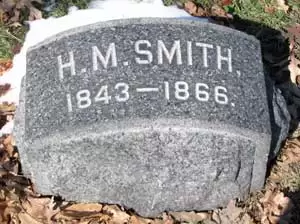
SMITH, HOBART M. (1843-1866). Corporal, 47th Regiment, New York State National Guard, Company A. After Smith enlisted at Brooklyn as a corporal on May 27, 1862, he immediately mustered into the 47th Regiment, and mustered out after three months on September 1 at Brooklyn. He last lived at 12 South 9th Street in Brooklyn. He died from dysentery. Section 114, lot 17046.
SMITH, JACOB W. (1844-1864). Private 5th New York Heavy Artillery, Company C. A Long Island native, he enlisted as a private at Huntington, Long Island, on August 26, 1862, and mustered into the 5th New York Heavy Artillery two days later. He was killed in action at Snicker’s Gap, Virginia, on July 18, 1864. On June 11, 1869, he was re-interred at Green-Wood. Section 75, lot 5627.
SMITH, JAMES D. (1827-1896). First lieutenant, 56th Regiment, New York State National Guard, Company F. After enlisting as a first lieutenant at Brooklyn on July 11, 1864, Smith was commissioned into the 56th Regiment on August 2, served 100 days, and mustered out on November 6 at New York City. His last address was 419 17th Street in Brooklyn. Section 200, lot 27009.

SMITH, JAMES R. (1841-1886). Second lieutenant, 10th New York Infantry, Company E. Smith, who was born in Philadelphia, Pennsylvania, enlisted at New York City as a sergeant on April 26, 1861, and mustered into Company E of the 10th New York four days later. He became second lieutenant on September 21, 1861, and resigned his commission on December 4, 1862. His last address was in Morrisville, Pennsylvania, where the cause of his death was listed as “struck by an engine.” Section 86, lot 1896, grave 87.

SMITH, JAMES W. (1823-1872). Private, 12th New York Infantry, Company E. Born in New York City, Smith enlisted as a private at Brooklyn on October 1, 1861, and mustered into the 12th New York that same day. He was discharged for disability on December 11, 1862. He last resided at Flushing Avenue in Brooklyn. Section 2, lot 7528.

SMITH, JESSE C. (or E.) (1808-1888). Brigadier general, United States Volunteers General Staff. Originally from Butternuts in Otsego County, New York, Smith was a graduate of Union College, class of 1832. He went to New York City to study law with Alva Clark, the abolitionist. After establishing a law practice in Brooklyn, he was appointed Kings County Surrogate from 1850 through 1854. Greatly interested in the New York State Militia, he attained the rank of colonel. His obituary in The New York Times reports that during his command of the 14th Regiment, he put down “Angel Gabriel” riots in 1856, led by a crank pretending to be the Angel Gabriel, on Atlantic Avenue in Brooklyn.
Active in politics, Smith was elected as a Republican to the New York State Senate in 1862-1863. As a State senator, where he headed the Military Affairs committee, he was instrumental in reorganizing the National Guard. The biographical sketch of Smith as a legislator notes that he was not a particularly effective speaker, voted against the popular joint resolution inviting General George McClellan to visit the capital, and was not approachable to those who sought business favors. His appearance was described as: medium size, dark eyes, black crispy hair, stubby whiskers, with an industrious and energetic demeanor. He was active in raising the 139th Regiment, and was empowered to raise the 11th Brigade. An article in the July 15, 1862, Brooklyn Daily Eagle, notes that “The organization of the 11th brigade, under General Jesse C. Smith, is proceeding as rapidly as can be expected under the present circumstances….”
Smith enlisted as a brigadier general and was commissioned into the United States Volunteers General Staff on June 18, 1863. He commanded the 11th Brigade at the Battle of Gettysburg, Pennsylvania. Smith was discharged on July 24, 1863, from New York National Guard, and resigned his commission in 1868. The census of 1870 indicates that was employed as a lawyer whose real estate totaled $25,000. His obituary states that he was a vestryman in St. Ann’s Church and a member of Abel Smith Post #435 of the G.A.R.. His son-in-law was Frank Godine (see). He last lived at 143 Willow Street in Brooklyn. Section 76, lot 131.

SMITH, JOHN C. (1842-1922). Sergeant, 5th New York Infantry, Company D; unknown rank, United States Navy. Smith was born in New York City and was baptized on September 3, 1843, when he was 16 months old. He may be the John C. Smith who first served in the United States Navy on the frigate Potomac and the USS Vincennes and the USS North Carolina from August 3, 1861 through April 17, 1862. He enlisted as a private on August 25, 1862, and mustered into Company D of the 5th New York. As per his muster roll, Smith was a clerk who was 5′ 4½” tall with hazel eyes, dark hair and a dark complexion. On an unknown date, he was promoted to sergeant and detailed on recruiting service under Lieutenant Colonel Hull. He was admitted to Ladies Home General Hospital in New York City on November 27, 1862, suffering from congestion of the brain. He was discharged for epilepsy, a condition that he had for six years, on January 13, 1864.
Smith was married in New York City on November 8, 1864. As per the 1880 census, he was living with his wife, Catherine, at 417 Broome Street in Manhattan and was working as a painter. His wife died in 1886. As per the census of 1900, he was a widower who was a resident at the Soldiers Home in Bath New York; in 1910, he was residing at the Soldiers Home in Washington, Tennessee. Records from his stay at a third Soldiers Home in Hampton, Virginia, in 1906 show that he was a 64 year-old widower who had been employed as a clerk; he was Protestant, 5′ 6″ tall with brown eyes, dark hair and a dark complexion. That document lists Emma Smith of New York City as his closest relative. Smith last lived at 436 West 17th Street in Manhattan. He died at Bellevue Hospital from nephritis. Section 114, lot 8999, grave 1125.
SMITH, JOHN FREDERICK (1840-1917). Sergeant, 8th New York Infantry. Born in New York City, Smith’s obituary in the Brooklyn Daily Eagle states that he served “with distinction” with the 8th New York during the Civil War. He may have been the John Smith who enlisted as a sergeant at New York City on May 29, 1862, mustered immediately into the Field and Staff of the 8th New York, and mustered out on September 10, 1862, at New York City. His Civil War service is also noted in his obituary in The New York Times. Active in military affairs, he was a past vice-commander of the Barbara Frietchie Post #11 of the G.A.R. In civilian life, Smith was a ship joiner for many years at the Brooklyn Navy Yard. His last residence was 1087 Sterling Place in Brooklyn. Section 115, lot 21016, grave 26.
SMITH, JOHN HYATT (1824-1886). Clergyman, United States Christian Commission. Born in Saratoga, New York, he was taught by his father and then worked as a bank clerk in Albany, New York, while studying theology. In 1848, his first pastoral position was in Poughkeepsie, New York, from where he moved to Cleveland, Ohio (1851-54); then Buffalo, New York (1855-60); and Philadelphia, Pennsylvania (1860-66).
In 1862, Smith served in Virginia with the United States Christian Commission. The U.S. Christian Commission, which began after the Battle of Bull Run, Virginia, was religious in nature but worked with the Sanitary Commission to provide medical and social services to men at the front. The original association developed through the efforts of the YMCA and Protestant clergymen. He moved to New York where he continued his ministerial duties in Brooklyn from 1866-1880. In 1869, he was chaplain for the 47th Regiment, New York National Guard. He served in Congress in 1881-1883 from the Independent Party and then returned to Brooklyn where he resumed his ministry. Section ?, lot ?.

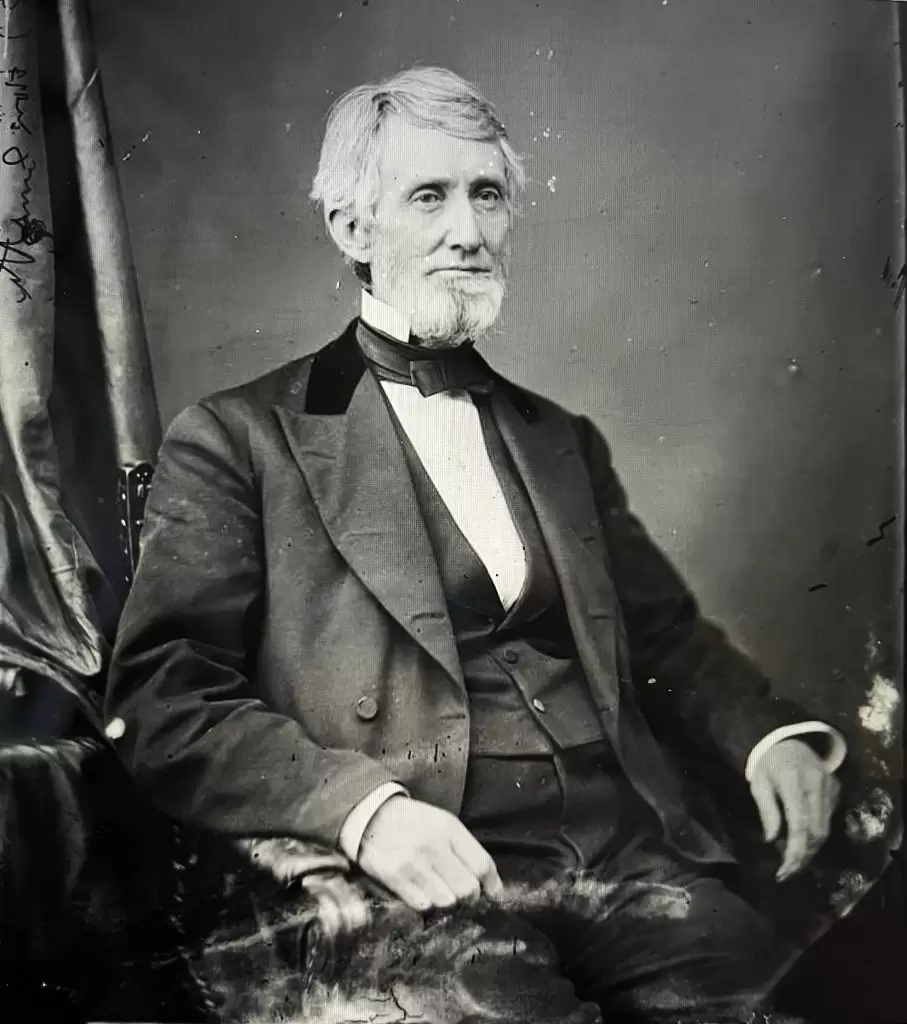
SMITH, JOSEPH HENRY (1839-1941). Private, 11th New York Infantry, Companies E and F. After enlisting as a private at New York City on April 20, 1861, he mustered into Company E of the 11th New York on May 7, was transferred to Company F on October 10 of that year and mustered out at New York City on June 2, 1862. He last lived in East Orange, New Jersey. Section 103, lot 4583.

SMITH, JOSEPH W. (or N.) (1841-1913). Private, 2nd New Jersey Infantry, Company G. A native of Trenton, New Jersey, Smith enlisted there as a private, on April 26, 1861. On May 1, 1861, he mustered into the 2nd New Jersey from which he was discharged on July 31, 1861, at Trenton. In 1891, his application for an invalid pension was granted, certificate 810,882. He last resided at the Soldiers’ Home in Kearny, New Jersey; that facility, which opened in 1888 at that site, was the final home for 25,000 veterans. In 1913, his wife applied for and received a widow’s pension, certificate 766,822. Section 183, lot 19594.
SMITH, ROBERT B. (1834-1862). First sergeant, 51st New York Infantry, Company B. Born in Brooklyn, he enlisted at New York City and mustered into the 51st New York on October 15, 1861. Smith was killed in battle on March 14, 1862, at New Berne, North Carolina. Interment at Green-Wood was on April 24 of that year. Section 12, lot 11810.
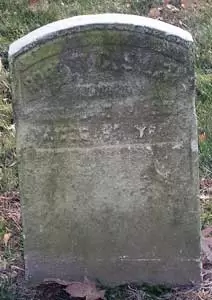
SMITH, ROBERT G. (1840-1909). Landsman, United States Navy. A native of New York City, Smith enlisted on September 12, 1862, and served on board the USS Vanderbilt and USS North Carolina before his discharge on January 17, 1864. A member of the McPherson-Duane Post #499 of the G.A.R., he was awarded a Navy invalid pension, certificate 593,368, in 1891. He last lived at 1446 72nd Street in Brooklyn but died at the Brooklyn Navy Yard. His widow, Alice Smith, applied for a pension in 1909. Section 164, lot 14947, grave 3.
SMITH, ROBERT HARMER (1824-1910). Corporal, 61st New York Infantry, Company I. A native New Yorker, he enlisted there as a private on May 27, 1864, and mustered in the same day. He was promoted to corporal on January 6, 1865. Wounded at Fort Stedman, Virginia, on March 25, 1865, he was discharged for disability on June 6, 1865, at Washington D.C.
As per his obituary in the Brooklyn Daily Eagle, Smith was in the electrotyping and stereotyping business on Beekman Street in Manhattan until 1894 at which time he joined his sons in their printing establishment. A member of the Society of Old Brooklynites, Smith was also a life member of the Typotheta of New York City, an association dedicated to improvements in the printing trade. His last residence was at 30 Herkimer Street, Brooklyn. Section 108, lot 1745, grave 13.

SMITH, SAMUEL C. (1843-1901). Sergeant, 71st Regiment, New York State Militia, Company I. Smith’s unit, the 71st Regiment, mustered and served from May 3-July 31, 1861. Section 45, lot 5271.
SMITH, SMITH (1822-1899). Private, 84th New York (14th Brooklyn) Infantry, Company E; Veteran Reserve Corps. Born in Brooklyn, he was a member of an old Long Island family of whalers and seamen. His forename was shared by the first born of several generations. In 1850, he went to work as a messenger at the Brooklyn Navy Yard and worked there, with only an interruption for his service during the Civil War, until 1895.
At the age of 40, Smith enlisted at Brooklyn on August 26, 1862, and mustered into the 14th the next day. He transferred to the Veteran Reserve Corps on November 15, 1863. After the War, he was a member of the Fourteenth Regiment War Veterans’ Association and the Rankin Post #10 of the G.A.R. During the Spanish-American War, he briefly came out of retirement to go back to work at the Navy Yard. At the time of his death, according to his obituary in the Brooklyn Daily Eagle, he was the oldest surviving member of the 14th, and was known as the father of that regiment. He died at 18 Vanderveer Street, his Brooklyn home. Section 135, lot 14964, grave 627.
SMITH, THEODORE E. (1845-1928). Assistant paymaster, Union Army. A Brooklynite by birth, Smith enlisted in the Union Army in August 1861 as an assistant paymaster serving in that rank until May 1865 when he was discharged. He served aboard the USS Mystic and the USS Vicksburg, a ship built in 1863. He last lived at the Hotel Bossert at 98 Montague Street in Brooklyn Heights, an apartment hotel known for its views of Manhattan. Section 68, lot 400.
SMITH, THOMAS (1840-1863). Corporal, 1st New York Mounted Rifles, Company H. Born in England, Smith enlisted and mustered into the 1st New York Mounted Rifles on August 11, 1862, at New York City. During his service he was promoted to corporal on an unknown date. He was killed in battle at Charles City Court House, Virginia, on December 13, 1863, and was interred in Green-Wood ten days later. Section 115, lot 8999, grave 530.
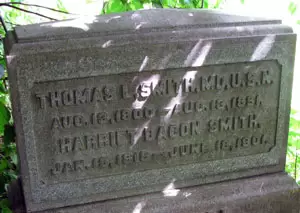
SMITH, THOMAS LUDINGTON (1800-1891). Surgeon, United States Navy. A native of Orange, New Jersey, Smith’s father was a well-to-do farmer and his maternal grandfather, Thomas Ward, was known for his activities in the Revolutionary War. Educated at the Orange Academy, he began his medical studies when he was only 17 and worked with a physician in Newark. In 1822, he graduated from the College of Physicians and Surgeons in New York City and a year later, received a degree from the New York Eye and Ear Infirmary. After practicing in Orange for a year, he returned to Manhattan where he had an office on Murray Street.
Smith became interested in the military, was appointed surgeon of the 82nd New York State Regiment in 1827, then joined the United States Navy as a surgeon’s mate on January 3, 1828, served in Brazil beginning in 1830, first on the Hudson and for three years aboard the Franklin and was later promoted to surgeon by President Andrew Jackson in 1837. His service took him to the West Indies, the Mediterranean and then the Brooklyn Navy Yard in 1847-49. Before returning there in 1854, he was sent to China and was the fleet surgeon for Commodore Perry’s expedition to Japan. He spent two years in Africa before the start of the Civil War.
Although Smith was on the retirement list on August 13, 1862, he chose to remain on active duty and was in charge of the Naval Hospital at the Brooklyn Navy Yard during the Civil War. He was promoted to medical director of that hospital with the rank of commodore on March 3, 1871, and retired later that year. He last resided at 169 Joralemon Street in Brooklyn. According to his obituary, his home was filled with trophies from his world travels. Section 151, lot 17912.

SMITH, WASHINGTON T. (or I.) (1839-1872). Corporal, 3rd New York Cavalry, Company C; private, 1st New York Mounted Rifles, Company I; 4th Provisional Cavalry, Company I. Born in New York State, Smith enlisted as a private and mustered into the 3rd New York Cavalry on August 3, 1861, at Rochester, New York. On October 15, 1861, Smith was promoted to corporal. Subsequently, Smith re-enlisted on January 5, 1864, and was reduced in rank to private on August 4, 1864. On July 21, 1865, he transferred into Company I of the 1st New York Mounted Rifles and on September 6, was transferred into Company I of the 4th New York Provisional Cavalry. He was discharged on November 13, 1865, at Richmond, Virginia. His last residence was 132 Ninth Avenue in Manhattan. Section 44, lot 3698.

SMITH, WILLIAM C. (1843-1907). Private, 23rd Regiment, New York State National Guard. The son of Brooklyn’s fourth mayor, Smith served for 30 days in 1863 with the 23rd Regiment’s National Guard. A celluloid manufacturer, he was a member of the New York Celluloid Company, the Brooklyn Club, and president of the Prospect Park South Association. He died at his home at 136 Argyle Road in Brooklyn. Section 196, lot 28625, grave 2.

SMITH, WILLIAM L. (1844-1896). Private, 56th Regiment, New York State National Guard, Company F. Smith served for 30 days when the 56th Regiment was called up in 1863. This information is inscribed on Smith’s gravestone. He may have also served in the same company for 100 days in 1864, mustering out as an ordnance sergeant but because he has a common name, this information is uncertain. His last address was 221 Adelphi Street in Brooklyn. Section 200, lot 28500.
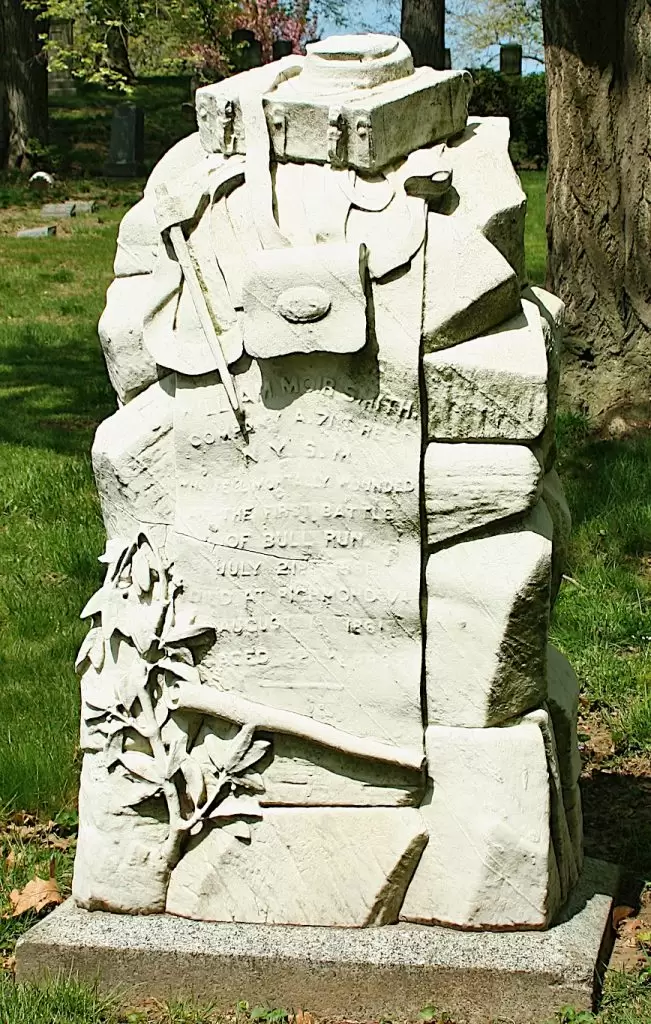
SMITH, WILLIAM MOIR (1839-1861). Lieutenant, 71st Regiment, New York State Militia, Company A. Smith was mortally wounded at the Battle of First Bull Run, Virginia, on July 21, 1861. Taken prisoner by the Confederates, he died at Libby Prison in Richmond, Virginia, on August 2, 1861. At a special meeting of the Alert Hose Company No. 3 of Brooklyn on August 23, 1861, a memorial certificate enumerating resolutions of condolence was written to honor his service, acknowledge his noble duty to the Union, and offer condolences to his family. Smith’s firefighter comrades offered “his bereaved family our most sincere and warmest sympathies, tempered however with the consolation that he nobly did his duty unto the end.”
Smith was interred at Green-Wood on October 22, 1865, after his body was returned to the North. A fine marble monument decorates his grave. The memorial certificate was sold for $750 on eBay in September 2015. Section 75, lot 5007.
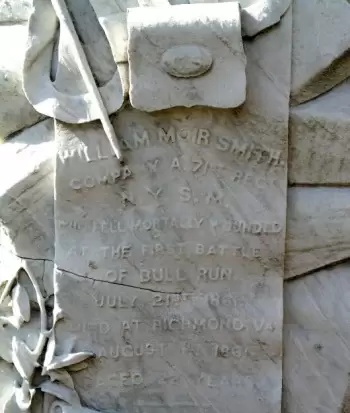

SMITH, WILLIAM N. (1828-1869). Private, 8th New York Heavy Artillery, Battery G. Smith, who was born in New York State, enlisted as a private on December 28, 1863, at Alexander, New York, and mustered into the 8th Heavy Artillery on January 4, 1864. He was wounded in action at the Battle of Petersburg, Virginia, on June 17, 1864, and mustered out on May 15, 1865, at Elmira, New York. He last lived in New York. Section 177, lot 14762.
SMITH, YEELING R. (1828-1871). Private, 15th New York Engineers, Company C. Originally from England, Smith enlisted as a private at New York City on May 12, 1864, mustered into the 15th Engineers that day, and mustered out on June 13, 1865, at Fort Barry, Virginia. His last address was 39 2nd Street in Brooklyn. Section 62, lot 7659.
SMYTHE, EDWARD D. (1834-1919). Captain, 90th New York Infantry, Company G; corporal, 13th Regiment, New York State Militia, Company A. Of Irish birth, he enlisted at Brooklyn on April 23, 1861, mustered into the 13th on May 16, returned to ranks on July 6, and mustered out with his company at Brooklyn on August 6, 1861. He re-enlisted as a first lieutenant on September 30, 1861, mustered into the 90th New York on July 29, 1862, and was promoted to captain on that day. Smythe mustered out on December 10, 1864, at New York City. In 1890, his application for an invalid pension was granted, certificate 790,451. He last resided on West 123rd Street in Manhattan. His widow, Mary D. Smythe, received a pension in 1919, certificate 872,009. Section 158, lot 14562.
SNEDIKER, ALONZO V. B. (1840-1872). Private, 84th New York (14th Brooklyn) Infantry, Company H. After Snediker enlisted as a private at Brooklyn on April 18, 1861, he mustered into the 14th Brooklyn on May 23, and deserted on January 23, 1862, at Upton’s Hill, Virginia. His last residence was on Myrtle Avenue in Brooklyn. Section 114, lot 8999, grave 1283.

SNELL, IRVING (or ERVING) (1842-1898). Private, 5th New York Infantry, Company I. He enlisted at New York City on July 3, 1861, and was discharged for a disability in October of that year at Baltimore, Maryland. Section 135, lot 30010, grave 40.
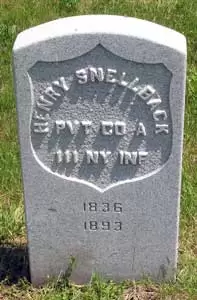
SNELLBACK, HENRY (1836-1893). Private, 111th New York Infantry, Company A. Born in Bavaria, he enlisted on August 20, 1862, as a private, and mustered into Company A of the 111th New York the same day. He served the duration of the War and mustered out on June 4, 1865, at Alexandria, Virginia.
As per his obituary in the New York Herald, Snellback was a member of the Dahlgren Post #113 of the G.A.R., the Shamrock Club, and the General Committee of Tammany Hall; associates from those organizations were invited to attend his funeral. Last residing at 146 Park Row, Manhattan, he died at Chambers Street Hospital of a pistol shot wound to the head. In 1894, Mary K. Snellback, who is interred with him, applied for and received a widow’s pension, certificate 401,788. Section 135, lot 27263, grave 660.
SNIFFEN, JOHN (1841-1917). Landsman, United States Navy. Born in New York City, Sniffen, a 5’4″ African-American, was a shoemaker and waiter at the time of his enlistment in the Navy on September 29, 1863. His muster record includes service on the following dates, all on the vessel USS Grand Gulf: October 9, 1863; January 1, 1864; February 23, 1864; April 1, 1864; June 30, 1864; September 23, 1864. He last resided in Easton, Pennsylvania. Section 181, lot 18948.

SNOW, FRANCIS M. (1840-1871). First sergeant, 6th New York Cavalry, Company B. Snow, who was born in Connecticut, enlisted as a private at New York City on August 6, 1862, and mustered into the 6th New York Cavalry five days later. He was promoted to corporal on March 1, 1863, sergeant on March 19, and became a first sergeant on August 15, 1864. He was likely the brother of Lowell Snow (see). He last lived in Hartford, Connecticut, where his death was listed as a casualty. Section 74, lot 8252.
SNOW, LOWELL M. (1839-1879). First lieutenant, 5th Connecticut Infantry, Companies B and I. Originally from Connecticut and a resident there of Chaplin, Snow enlisted on June 21, 1861, as a corporal. He mustered into Company B of the 5th Connecticut on July 22, and was promoted to sergeant of his company on October 1. On August 9, 1862, he was taken prisoner of war at the Battle of Cedar Mountain, Virginia, and was paroled on September 15. He re-enlisted and returned to his company as a sergeant on December 21, 1863. On July 20, 1864, he was wounded in action at the Battle of Atlanta, Georgia. Snow received a promotion to first sergeant on March 1, 1865, and subsequently rose to first lieutenant on May 20 effective upon his transfer to Company I. He was discharged from military service on July 19, 1865, at Alexandria, Virginia.
According to the 1870 census, Snow was living in the Greenpoint section of Brooklyn. His last residence was 85 East 93rd Street in Manhattan. In 1890, Mary Snow applied for and received a widow’s pension, certificate 328,155. Section 74, lot 8252.

SNOW, WILLIAM B. (1845-1878). First lieutenant, 26th Pennsylvania Infantry, Company I. A native of Orleans, Massachusetts, Snow enlisted as a first lieutenant on May 31, 1861, and was immediately commissioned into Company I of the 26th Pennsylvania Infantry from which he resigned on January 15, 1862. He last lived in Bradford, Pennsylvania. Section 154, lot 22788.
SNYDER, GUSTAVE (or GUSTAV) (1840-1871). Private, 68th New York Infantry, Company C. Of German origin, Snyder was a private in the 68th New York. Further details are unknown. He last lived at 27 Stanton Street in Manhattan. Section 159, lot 13265.
SODEN, JOHN G. (1848-1940). Sergeant, 8th United States Infantry, Company A. Born in Ireland, Soden came to the United States in 1850. His obituary, published in The New York Times on August 10, 1940, contained the headline, Veteran of the Civil War, Who Enlisted When 15, Dies at 92, and recounted that when the Civil War broke out, Soden applied for enlistment but was turned down. Later, when he added a few years to his age, he was accepted. Once in the 8th U.S. Infantry, he fought at Gettysburg, Pennsylvania, and also at the Wilderness, Virginia, being wounded once in the leg.
After the War, Soden was for many years a clerk in the Supreme Court. He filed for an invalid pension in 1878, certificate 310,981. The Surviving Soldiers, Sailors, and Marines Listing for Brooklyn in June of 1890 confirmed his military service. According to an article in The New York Times dated December 13, 1936, Soden was among the six attendees at the 70th meeting of his G.A.R. Post out of a total of fifteen surviving members. The article noted that Soden, 88 years old and the junior member of the group, “was afraid that he was getting just a little too near-sighted and perhaps a little too hard of hearing to continue as the secretary-treasurer and would quit if the eldest member, 95 year old Robert Sommers, who still plays the piano and sings, could see a bit better.” At the time of his death, Soden was quartermaster of the Rankin Post #10. His last residence was 1041 Sterling Place, Brooklyn. Section 169, lot 14511.
SOMERVILLE (or SUMMERVILLE, SOMMERVILLE, SUMERVILLE), JAMES (1816-1863). Private, 79th New York Infantry, Company D. Somerville was born in Kinkardge in Perthshire, Scotland. He married Margaret Masterton in Scotland on September 3, 1841. As per the 1855 New York State census, which spells their surname “Sumerville,” he lived in Manhattan with his wife and daughters Rachael, 15; Isabela, 13; Margaret, 11, Selia, 9, Jennett, 7, William, 5; and James, 3. The 1860 census notes that he was a stone mason whose personal estate was valued at $200. Nine children are listed: Rachael (18), Isabella (16), John (14), William (12), Margaret (10), Celia (8), Jennot (7), James (5) and Archibald (1).
Somerville enlisted as a private at New York City on May 13, 1861, at the age of forty-five to serve for three years, as per his discharge papers, prepared at Fredericksburg, Virginia, on January 8, 1863, He mustered into Company D of the 79th on May 28. At that time, he was 5′ 11½” tall with a fair complexion, blue eyes, and fair hair. He listed his occupation as stone cutter. The discharge papers report that he has been unfit for duty due to partial paralysis resulting from sunstroke in the line of duty and dating back to his enlistment. His muster roll, which has the surname Sommerville, indicates that he was borne as “Charles” and discharged for disability by order of a surgeon at Annapolis, Maryland. A Proof of Death document notes that in September 1861, while his brigade was undergoing a review, he fell to the ground with sunstroke while performing actual duty. He died in New York City on August 3, 1863.
On June 10, 1864, Margaret Somerville appeared before the clerk in the Court of Records in New York County, in an effort to secure a widow’s pension, as provided by an act of Congress approved on July 14, 1862. That document, Declaration for Widow’s Army Pension, validates that James Somerville suffered from partial paralysis due to sunstroke but adds that he also suffered from fatigue and exposure at Fredericksburg. She declared the couple had three children under the age of sixteen: Celia (Cecilia), born in Scotland in 1850, Janet born in New York 1853, and James, born in New York in 1856. (The Family Register pictured below shows the births of nine children.) Mrs. Somerville declared that the children lived with her in New York City and that she was faithful to the Union. Her petition bore her signature and was signed by two witnesses.
As of July 23, 1866, Mrs Somerville was granted a pension of $8 per month, dating back to August 3, 1863, and two additional dollars per month for each of the three children living with her under claim number 112,431. On December 6, 1866, Mrs. Somerville appeared before the commissioner of deeds requesting an increase in her pension; the document was marked with her X rather than a signature; the claim number was 68,038. Another document, signed with her X on August 24, 1867, notes that Mrs. Somerville could not have signed the first application because she was illiterate. In addition, that document notes that the birth of Cecilia was in 1851, and that the page torn from the family Bible listing the births of her children was written by her husband. Further, she claims that the Sanitary Commission or someone in Washington lost her marriage certificate and despite her efforts and expense to secure a copy of that information from Scotland and its resubmission, it was again misplaced. A physician’s letter to the Protective War-Claim Association of the United States Sanitary Commission indicates that Somerville died from asthenia, complicated by sunstroke and nervous tremors that were incurred during his military service to the United States. The physician who attended the births of Janet and James wrote that Somerville was in good health when he enlisted. Another affidavit signed by a comrade of James, William Lawson, states that James suffered from sunstroke in September and October of 1861; that document was signed on September 9, 1867.
At the time of Mrs. Somerville’s death from phthisis, she was listed as a widow, living in the United States for 17 years. Mrs. Somerville received a pension until her death on October 28, 1869, as noted on the application for a pension for her minor children. As of October 29, 1869, a pension of $8 per month for minor children, Janet (Jeanette) and James was awarded, certificate 151,942. In 1871, Isabella MacPherson, 25, of Morrisania, New York (likely the sister of the minor children), filed guardianship papers for those children and pension payments were forwarded to her as of June 1871. The Somervilles are listed in Green-Wood’s database as Summerville, although no official papers have that spelling. Section B, lot 8575, grave 406.


SONNER, PETER (1821-1862). Sergeant, 4th New York Infantry, Company D. After he enlisted as a sergeant at New York City on April 22, 1861, he mustered into the 4th New York on May 2, was discharged for disability on August 3, 1862, at Suffolk, Virginia, and died three months later on November 4. Section 115, lot 11193.

SORGER (or SOYER), MORITZ (1843-1873). Sergeant, 17th New York Infantry, Company K; private, 3rd New York Infantry, Company I; 38th New York Infantry, Company A. Born in Germany, he served in several New York infantry regiments, enlisting for the first time on April 28, 1861, at Albany, as a private, and serving with the 3rd New York from May 14, 1861, until he mustered out on May 21, 1863. He re-enlisted as a private at New York City on July 18, 1863, mustering into the 38th New York on September 14. He transferred into the 17th Infantry on October 14, where he remained until July 13, 1865, during which time he was promoted to sergeant on May 1, 1864. Sorger died of alcoholism. He last lived at 147 Hudson Avenue in Brooklyn. A Veterans Administration stone was ordered for him early in the 20th century. Section 115, lot 13536 (Soldiers’ Lot), grave 12.
SORIA, ISAAC HENRY (1838-1884). Sergeant, 37th Regiment, New York State National Guard, Company E. Born in New York, he enlisted at New York City as a sergeant on May 29, 1862, and mustered out with his company after three months on September 2. He last lived in Newark, New Jersey. Section 122, lot 17806, grave 27.

SOULE, BENJAMIN D. (1842-1876). Private, 2nd New York Heavy Artillery, Company E. Soule, who was born in Staten Island, enlisted there as a private on October 2, 1861, and mustered into Company E of the 2nd Heavy Artillery that same day. After re-enlisting and returning to his company on November 23, 1863, he mustered out on September 29, 1865, at Washington, D.C. His last residence was 245 Jersey Avenue, in Jersey City, New Jersey. Section 31, lot 10035.
SOUTHARD, JAMES (1844-1919). Sergeant, 126th New York Infantry, Company G; 75th Veteran Reserve Corps, 2nd Battalion. A Brooklyn native, Southard enlisted as a private on August 13, 1862, at Waterloo, New York, and mustered into Company G of the 126th New York on August 22. After being captured on September 15, 1862, at Harpers Ferry, Virginia, he was paroled there the next day. On January 6, 1863, he was promoted to corporal of his company and, on January 1, 1864, rose to sergeant. After being wounded in action at the Battle of the Wilderness, Virginia, on May 6, 1864, he transferred into the 75th Veteran Reserve Corps, 2nd Battalion, as a sergeant. He mustered out on July 1, 1865, at Washington, D.C. Southard was a member of the Cushing Post #231 of the Grand Army of the Republic. His last residence was 133 22nd Street in Brooklyn. Section 17, lot 14888, grave 318.

SOUTHWELL, JOHN F. (1852-1899). Private, 5th United States Artillery, Company C. He enlisted as a private, date unknown. According to his government-issued gravestone, circa 1900, he served in the 5th U.S. Artillery. His last residence was 284 7th Avenue, Brooklyn. Section 135, lot 30010, grave 417.
SOUTHWICK, EMUEL (1837-1891). Paymaster, 31st Regiment, New York State Militia. Born in Massachusetts, Southwick was living in Worchester, Massachusetts, according to the census of 1850. He enlisted as a paymaster on May 21, 1861, at New York City, mustered into the Field and Staff of the 31st Regiment that day, and mustered out on June 20.
The New York City Directory for 1862 listed Southwick as living on Long Island and employed as a lawyer at 33 Nassau Street in Manhattan. According to the City Directory for 1886, he was employed as a broker and lived at 2135 Fifth Avenue. Southwick’s family genealogy records indicate that he was both a lawyer and stockbroker. His last residence was 12 East 130th Street in Manhattan where he died from cirrhosis. Section 177, lot 13763.
SOUTHWICK, JONATHAN REEVES (1845-1925). Private, 23rd New Jersey Infantry, Company E. Southwick was born in New Jersey. After enlisting as a private on August 26, 1862, he mustered into the 23rd New Jersey on September 13. Southwick served during the Fredericksburg Campaign of December 1862 and the Chancellorsville Campaign of May 1863. He mustered out on June 27, 1863, at Beverly, New Jersey. He later served as a commissary sergeant in the United States Army, in the General Service of the United States Army, and as a quartermaster sergeant in the 2nd United States Cavalry, Company K. Some of that service was after the War; no specific dates are available. Adaline Southwick, who is interred with him, applied for and received a widow’s pension in 1925, certificate 966,831. He was also survived by three children. Section 130, lot 36529.


SOUTHWORTH, EDWARD B. (1837-1919). Acting assistant paymaster, United States Navy. Born in Providence, Rhode Island, Southworth served in the Navy as an acting assistant paymaster during the Civil War. As per his obituary in the Brooklyn Standard Union, which notes his Naval service in the Civil War, Southworth served aboard the USS Amanda and the USS Great Gulf and witnessed the famous battle of the USS Monitor v. the USS Merrimack (CSS Virginia).
A member of the Ulysses S. Grant Post #327 of the G.A.R., Southworth was in business in Brooklyn before moving to New Jersey in 1913. The inscription on his government-issued stone that was placed on his grave early in the 20th century confirms his service. He last lived at 19 Audrey Road in Upper Montclair, New Jersey. Section 93, lot 1435.

SOUTTER, ROBERT (1841-1873). Second lieutenant, 1st Regiment, Georgia Regulars; private, Savannah Volunteer Guards, Company A, Confederate States of America. A Virginia native, he enlisted as a private on March 3, 1862, at Savannah, Georgia, and mustered into Company A of the Savannah Volunteer Guards, that eventually became the 18th Battalion Georgia Infantry. As of October 10, 1862, he was detailed by order of General Beauregard to the Signal Corps where he was a signal operator. Soutter wrote to CSA Secretary of War James Seddon on December 28, 1862, asking for a “favor” and noting that his work in the Signal Corps was “not one exactly suited to my ambition.” He wrote, “…Any position my dear Sir, that you would think was suitable for me, that you could get for me you will find a grateful relative. Artillery I should prefer ‘but beggars are not choosers.’…” Robert’s father, writing from Paris on February 28, 1863, to Seddon, urged his “dear friend” to promote his son to “a staff appointment” or any position of “trust.”
In another letter written by G. B. Lamarr, most likely Robert’s father-in-law, dated May 27, 1863, it was noted that at the onset of the Civil War, Soutter’s family fled to Canada. Soutter then returned to join the Savannah Volunteers. Lamarr attested Soutter’s dedication to the Confederacy and his faithful execution of duties on its behalf. General William B. Taliaferro also wrote in May 1863 in support of Soutter reiterating that he came South from New York to enlist. Secretary of War Seddon replied to Taliaferro and inquired if there was an opening for a second lieutenant in the Georgia Regulars. Soutter was appointed to that rank on June 6, 1863, and served with the Georgia Regulars as a second lieutenant.
Soutter’s papers from that promotion indicate that he was appointed from Virginia. In a letter dated May 23, 1864, Soutter wrote to Secretary of War Seddon that he was informed that General Nathaniel Harris (see) of Mississippi wanted to appoint him his adjutant general. The New York City Directory of 1872 noted that he was a banker. He was the brother of William Knox Soutter (see). He last lived at 46 West 21st Street in Manhattan. Section 194, lot 29099, grave 2.
SOUTTER, WILLIAM KNOX (1844-1891). Signal officer, Confederate Navy, Confederate States of America. A native of Norfolk, Virginia, Soutter’s family was prominent in society in the South. His mother’s (Agnes T. Knox) family had estates on the banks of the Rappahannock River in Virginia. When Soutter’s parents married, they went North and lived in Astoria, New York, as per the censuses of 1850 and 1860, where James Soutter, William’s father, was president of the Bank of the Republic. According to his mother’s obituary, which referred to her as Mrs. James Soutter, her husband had roots in the South but was opposed to the War. In spite of his opposition to the hostilities, James Soutter’s estates were confiscated by order of the War Department and an order issued for his arrest. That obituary reported that James fled to Europe where he remained until the end of the War. However, one of William Soutter’s obituaries notes that James Soutter was suspected of being a financial agent of the Confederacy and fled to Canada to escape arrest. (James Soutter’s property was later restored to him by President Andrew Johnson and James became president of the Old Dominion Society in New York and was a trustee for many widows and orphans from the South.)
William Soutter, who attended Columbia College in New York City, enrolling at the age of sixteen, maintained his sympathies with the South. Although his obituary in The New York Times indicates that he left New York to enlist in the Confederate Army, his mother’s obituary and another obituary state that he served in the Confederate Navy. Soutter served as a signal officer on a blockade-runner, was taken as a prisoner of war and held at Fort Warren in Boston Harbor, and subsequently exchanged. He re-entered service and served until the war ended. Reportedly, his record of running the blockade of Southern ports thirty-five times is unequalled.
After the War, William Soutter and his brother, Robert (see), came to New York where their father established for them the banking house of Soutter Brothers. William became a member of the New York Stock Exchange in 1868. Soutter lived in New York City as per the 1870 census; the censuses for 1875 and 1880 report that he lived in Castleton and then West New Brighton, Staten Island. The 1880 census shows that there were six Irish servants in the household working for the family. Robert Soutter died in 1873; his widow, who later remarried and became the Duchess D’Anxy, sued William Soutter for mismanaging her estate of which he was the executor; William was exonerated of all charges.
His banking enterprise failed in 1885; his obituary reports that the failure was attributed to Soutter’s generosity in carrying the accounts of friends who had lost money. He was a prominent member of the Manhattan and Union Clubs. Soutter was considered to be one of the best dressed men in New York City but was also considered kind and modest. He last lived in an apartment in the Union League Clubhouse at 21st Street and Fifth Avenue in Manhattan. Soutter’s funeral was held at Trinity Church. As per his obituary in The New York Times, he had been in poor health for several months after contracting a cold while attending the funeral of Union General William T. Sherman; the cold developed into pleurisy and caused his demise. Section 79, lot 1.

SOUZA (or SOUZAI), JOSEPH (1839-1909). Corporal, 38th New York Infantry, Companies I and E; 40th New York Infantry. He enlisted and mustered into Company I of the 38th New York as a private at New York City on September 9, 1861, was promoted to corporal, transferred to Company E on December 21, 1862, and transferred into the 40th New York on June 3, 1863. According to his obituary in the New York Herald, Souza was a member of the Sheridan- Ellsworth Post #67 of the G.A.R.; comrades were invited to attend his funeral. He last lived at 343 East 139th Street in the Bronx. Section 127, lot 8899, grave 96.
SPACKMAN, FREDERICK (1841-1922). Corporal, 83rd New York Infantry, Company C. Born in London, England, Spackman enlisted as a private and mustered into the 83rd at New York City on May 27, 1861. After a promotion to corporal on or about April 15, 1863, he was reduced in rank to private on May 15. He was taken as a prisoner of war at Gettysburg, Pennsylvania, on July 1, 1863, and paroled on an unknown date. On June 23, 1864, he mustered out at New York City. His last address was 958 East 13th Street in Brooklyn. Section C, lot 35986, grave 2.


